
- Home
- Travel Packages
- Top Destination
-
Travel Attraction
By Category
Top Attraction

- Travel Agents
- Car Rentals
- Hotels
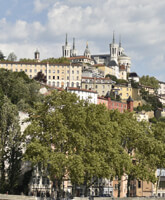
Fourvière Hill, Lyon Fourvière Hill is one of the most famous landmarks in Lyon, offering breathtaking panoramic views of the city. It is home to the magnificent Basilica of Notre-Dame de Fourvière and many historical sites. How to Reach Fourvière Hill, Lyon You can reach Fourvière Hill using the following modes of transport: By Funicular: Take the funicular from Vieux Lyon station to Fourvière. By Foot: A scenic but steep walk from Old Lyon. By Car: Parking is available near the basilica. Weather in Lyon Lyon has a temperate climate with the following seasonal variations: Spring (March-May): Mild and pleasant. Summer (June-August): Warm, with temperatures reaching up to 30°C. Autumn (September-November): Cool with occasional rain. Winter (December-February): Cold, sometimes dropping below freezing. Timing and Entry Details Fourvière Hill is accessible 24/7, but specific sites like the basilica have visiting hours. Why is Fourvière Hill Famous? Fourvière Hill is known for: The Basilica of Notre-Dame de Fourvière, an architectural marvel. Stunning views of Lyon from its summit. Its Roman ruins, including an ancient amphitheater. History and Architecture Fourvière Hill has historical significance dating back to Roman times. The Basilica, built in the 19th century, showcases intricate mosaics and stunning architecture, blending Romanesque and Byzantine styles. Things to Do at Fourvière Hill Visit the Basilica: Explore its grand interiors and stained glass windows. Enjoy the View: Capture stunning panoramic photos of Lyon. Explore the Roman Ruins: Discover the ancient theater and museum. Interesting Facts about Fourvière Hill The name "Fourvière" comes from the Latin "Forum Vetus," meaning Old Forum. The hill has been a place of pilgrimage for centuries. The Basilica was built to thank the Virgin Mary for saving Lyon from plagues and wars. Tips for Visiting Visit early in the morning to avoid crowds. Wear comfortable shoes if walking up the hill. Take a guided tour to learn about the rich history.
Explore More
The Gallo-Roman Museum of Lyon-Fourvière is an archaeological museum that showcases the rich history of Lyon from its Roman past. Located near the ancient Roman theatres, it is a must-visit for history enthusiasts. How to Reach Gallo-Roman Museum, Lyon The museum is easily accessible through multiple transport options: By Metro: Take Line D to Vieux Lyon and then a short walk uphill. By Bus: Several bus routes stop near the museum. By Foot: Enjoy a scenic walk from the Fourvière Basilica. Weather in Lyon The climate in Lyon varies throughout the year: Spring (March-May): Pleasant and mild temperatures. Summer (June-August): Warm and dry, often reaching 30°C. Autumn (September-November): Cool and occasionally rainy. Winter (December-February): Cold with rare snowfall. Timing and Entry Details The museum is open daily except on Mondays. Entry fees apply, but discounts are available for students and seniors. Why is Gallo-Roman Museum Famous? The museum is well known for: Its extensive collection of Roman artifacts. The famous Lyon Tablet, an ancient bronze inscription. Being located next to Lyon's Roman theatre ruins. History and Architecture The museum was designed by architect Bernard Zehrfuss and opened in 1975. It is partially built underground to blend with the ancient ruins, and it houses relics from the Roman city of Lugdunum. Things to Do at the Gallo-Roman Museum Explore the Exhibits: View mosaics, statues, and ancient tools from the Roman era. Visit the Roman Theatre: Step into the past with the adjacent well-preserved amphitheater. Enjoy Interactive Displays: Learn about Lyon’s Roman history through engaging multimedia exhibits. Attend Cultural Events: The museum often hosts lectures and temporary exhibitions. Interesting Facts about Gallo-Roman Museum The museum is partially built underground to preserve the landscape. It houses one of the oldest known Roman mosaics in France. The Lyon Tablet contains a speech by Emperor Claudius. It is part of the Fourvière archaeological site, a UNESCO-listed area. Tips for Visiting Visit early to explore without crowds. Combine your visit with a trip to the nearby Fourvière Basilica. Check for temporary exhibitions for unique experiences. Wear comfortable shoes, as the site has uneven terrain.
Explore More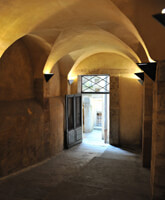
The Traboules of Lyon are secret passageways that date back to the Renaissance period. These unique pathways connect streets through buildings and courtyards, allowing residents and merchants to move quickly through the city. How to Reach Traboules Lyon, Lyon There are several ways to access the traboules: By Metro: Take Line D to Vieux Lyon and explore the traboules in the Old Town. By Bus: Various buses stop near Croix-Rousse, where many traboules are located. By Foot: The best way to experience the traboules is by walking through the historic districts. Weather in Lyon Lyon has a diverse climate throughout the year: Spring (March-May): Mild temperatures and blooming flowers. Summer (June-August): Warm and dry, ideal for walking tours. Autumn (September-November): Cool weather with occasional rain. Winter (December-February): Cold temperatures but still great for indoor visits. Timing and Entry Details Most traboules are open to the public, but some are within private residences. Guided tours are available for a deeper insight into their history. Why are Traboules Lyon Famous? The traboules are famous for: Being a symbol of Lyon’s silk industry. Playing a significant role in the French Resistance during World War II. Their unique architectural design blending passageways and courtyards. History and Architecture The traboules date back to the 4th century and were primarily used by silk workers to transport goods. They are characterized by beautiful Renaissance-style courtyards and spiral staircases. Things to Do at Traboules Lyon Explore Hidden Passageways: Discover the secret routes connecting different streets. Take a Guided Tour: Learn about the history and significance of the traboules. Visit Croix-Rousse: Experience the district where many traboules are located. Admire Architecture: Observe the mix of medieval and Renaissance designs. Interesting Facts about Traboules Lyon There are over 400 traboules in Lyon, but only around 40 are open to the public. Traboules helped silk workers efficiently move between workshops and markets. During World War II, they served as escape routes for the French Resistance. The longest traboule runs for 54 meters, connecting Rue Saint-Jean and Rue du Bœuf. Tips for Visiting Join a guided tour for a better understanding of their history. Respect private residences as some traboules are within apartment buildings. Wear comfortable shoes, as some paths are narrow and uneven. Visit early in the morning for a quieter experience.
Explore More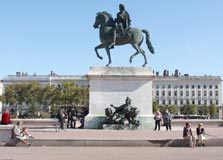
Place Bellecour is the largest square in Lyon and one of the biggest open squares in Europe. Located in the heart of the Presqu'île district, it serves as a major meeting point and a cultural hub of the city. How to Reach Place Bellecour, Lyon There are multiple ways to get to Place Bellecour: By Metro: Take Metro Line A or D to Bellecour station, which exits directly onto the square. By Bus: Several bus lines stop at Bellecour, making it easily accessible from different parts of the city. By Foot: If you're exploring Lyon’s city center, Place Bellecour is within walking distance of many attractions. Weather in Lyon Lyon experiences four distinct seasons: Spring (March-May): Pleasant weather with blooming flowers. Summer (June-August): Warm and ideal for outdoor activities. Autumn (September-November): Cooler temperatures with occasional rain. Winter (December-February): Cold, but still enjoyable with festive lights and events. Timing and Entry Details Place Bellecour is an open public space accessible 24/7 without any entry fees. Why is Place Bellecour Famous? The square is renowned for: Its central location, making it a hub for events and gatherings. The iconic equestrian statue of King Louis XIV. Being a starting point for major shopping streets such as Rue de la République. Its role in historic events and public demonstrations. History and Architecture Place Bellecour has a long history dating back to Roman times. Over the centuries, it has been used for military training, fairs, and public celebrations. The square features classical French architecture, with surrounding buildings that reflect Lyon's rich heritage. Things to Do at Place Bellecour Admire the Statues: Take a closer look at the statue of Louis XIV and the smaller sculptures of the brothers Jacquard. Enjoy Shopping: The square leads to famous shopping streets with luxury boutiques and local stores. Attend Events: Concerts, festivals, and public celebrations often take place in the square. Relax in the Gardens: The nearby small gardens provide a peaceful escape from the bustling city. Interesting Facts about Place Bellecour It is one of the largest pedestrian squares in Europe, covering about 62,000 square meters. During the French Revolution, the statue of Louis XIV was destroyed but later rebuilt in 1825. It has served as a meeting point for major political and social events in Lyon. It is the official starting point for measuring distances from Lyon to other cities in France. Tips for Visiting Visit during sunrise or sunset for stunning views of Fourvière Hill. Wear comfortable shoes, as the square is vast and best explored on foot. Look out for seasonal events, such as the Christmas market in winter. Use Place Bellecour as a reference point when navigating Lyon.
Explore More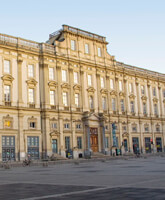
The Museum of Fine Arts of Lyon (Musée des Beaux-Arts de Lyon) is one of the most significant art museums in France, housing an extensive collection of paintings, sculptures, decorative arts, and antiquities. How to Reach Museum of Fine Arts of Lyon You can reach the museum through various transportation options: By Metro: Take Metro Line A and get off at Hôtel de Ville - Louis Pradel station, which is a short walk from the museum. By Bus: Several bus lines stop near the museum, including lines C3, C5, C13, and C18. By Foot: The museum is located in central Lyon, making it easily accessible on foot from major landmarks. Weather in Lyon Lyon has a temperate climate with distinct seasons: Spring (March-May): Mild temperatures with blooming flowers. Summer (June-August): Warm and sunny, ideal for sightseeing. Autumn (September-November): Cooler temperatures with colorful foliage. Winter (December-February): Cold but suitable for museum visits. Timing and Entry Details The museum is generally open from Tuesday to Sunday, with opening hours from 10 AM to 6 PM. It is closed on Mondays and public holidays. Entry fees vary, with discounts available for students and seniors. Why is the Museum of Fine Arts of Lyon Famous? The museum is well known for: Its impressive collection spanning from ancient Egyptian artifacts to modern art. Masterpieces from renowned artists such as Rembrandt, Monet, Picasso, and Rodin. Being one of the largest and most prestigious museums in France. History and Architecture The museum is housed in a former Benedictine convent dating back to the 17th century. Over the centuries, it has undergone numerous renovations to accommodate its growing collection. The building itself is a beautiful example of classical architecture with a stunning courtyard garden. Things to Do at the Museum of Fine Arts of Lyon Explore the Art Collections: Discover works from ancient civilizations to contemporary art. Visit the Sculpture Gallery: Admire stunning sculptures, including works by Rodin. Relax in the Garden: The museum’s inner courtyard is a peaceful retreat. Attend Temporary Exhibitions: The museum frequently hosts special exhibitions and events. Interesting Facts about the Museum of Fine Arts of Lyon The museum has over 70 rooms filled with art from various periods and cultures. It is considered one of the most important museums in Europe. The museum was established in 1801 and has continuously expanded its collection. It has one of the largest collections of sculptures in France. Tips for Visiting Plan at least 2-3 hours to explore the museum fully. Visit early in the day to avoid crowds. Check for temporary exhibitions for unique art experiences. Take advantage of free admission days if available.
Explore More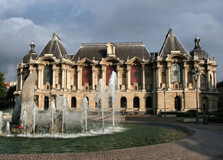
The Palais des Beaux-Arts in Lille is one of the most remarkable museums in France and is often considered the jewel of the city’s rich cultural heritage. Established in the 19th century, this grand museum offers visitors a chance to dive deep into the history of European art. From classical to modern art, it showcases an impressive range of works from various periods and regions. Whether you're an art enthusiast or a first-time visitor, the Palais des Beaux-Arts provides an enriching experience in the heart of Lille. How to Reach Palais des Beaux-Arts, Lille The Palais des Beaux-Arts is located in the city center of Lille, making it easily accessible from various parts of the city. If you're traveling by train, you can arrive at either Lille Flandres or Lille Europe stations, both of which are within walking distance from the museum. From Lille Flandres station, it's just a 10-minute walk to the museum. You can also take public transport, such as the metro (Ligne 1, stop at Rihour) or the bus, to reach the museum. If you're coming by car, parking is available nearby, though it's often easier to use public transport due to the city’s pedestrian-friendly environment. Weather in Lille The weather in Lille is temperate, with cool winters and mild summers. The city experiences moderate rainfall throughout the year, so it’s advisable to carry an umbrella or raincoat when visiting the Palais des Beaux-Arts, especially during the colder months (from November to March). Summer (June to August) offers pleasant temperatures, averaging around 20°C (68°F), which makes it ideal for outdoor exploration and enjoying the art museum. Opening Hours and Timings The Palais des Beaux-Arts typically operates with the following timings: Monday to Sunday: 10:00 AM - 6:00 PM Closed on Tuesdays It’s important to check the official website or call ahead before your visit, as the museum might have special timings or be closed for maintenance or holidays. It’s always best to plan your visit accordingly to make sure you have enough time to explore the museum at leisure. Why Palais des Beaux-Arts is Famous for Lille? The Palais des Beaux-Arts is famous for its exceptional collection of European art, which spans over 6,000 works, including paintings, sculptures, and decorative arts. It is one of the largest fine arts museums in France, second only to the Louvre in Paris in terms of the size and variety of its collection. The museum is renowned for its classical French art, Flemish paintings, and works by notable artists such as Rubens, Van Gogh, and Delacroix. What makes the museum even more special is its grand architecture. The museum building, constructed between 1885 and 1892, is an exquisite example of the Beaux-Arts style, with monumental staircases and decorative elements that add to its splendor. The Palais des Beaux-Arts is a must-visit attraction for anyone interested in experiencing art and history in a stunning, historical setting. Entry and Visit Details The museum charges an entry fee, but it also offers discounted tickets for students, senior citizens, and groups. Children under the age of 18 can enter for free, making it a great destination for families. You can buy tickets at the museum's entrance or online for added convenience. The Palais des Beaux-Arts offers guided tours in French and English for visitors who wish to learn more about the artworks on display. These tours give insight into the history of the collections, the artists, and the museum’s architectural significance. Audio guides are also available to enhance your visit. History and Architecture of Palais des Beaux-Arts The Palais des Beaux-Arts was designed by architect Louis-Marie Cordonnier and opened in 1892. The building’s grandeur and intricate detailing reflect the Beaux-Arts architectural style, with its classical facades, marble columns, and vaulted ceilings. The museum was created to house the art collections of the city and has since become an iconic symbol of Lille’s cultural pride. Over the years, the museum has been expanded and renovated, including a major renovation in the 20th century to modernize its galleries while preserving its historical charm. The building itself is an artwork, and the combination of the museum’s exterior beauty with the masterpieces inside makes it a unique cultural destination in northern France. Things to Do at Palais des Beaux-Arts Visiting the Palais des Beaux-Arts is more than just admiring artwork; it's an immersive experience. Here are some things to do when visiting the museum: Explore the Art Collections: Discover an extensive collection that includes paintings from renowned artists such as Rubens, Van Gogh, and Delacroix. You'll also find sculptures, antiques, and decorative arts. Admire the Architecture: Take time to appreciate the building’s Beaux-Arts style, its large staircases, and impressive galleries. Enjoy Temporary Exhibitions: The museum hosts temporary exhibitions showcasing modern artists, which are frequently updated, providing fresh content to regular visitors. Attend Art Events: The museum often organizes cultural events such as conferences, art workshops, and educational programs for all ages. Facts about Palais des Beaux-Arts The museum houses over 6,000 works of art, making it one of the largest fine arts museums in France. Some of the most famous artists in history, including Rubens, Van Gogh, and Delacroix, have works featured in the museum. The museum is located in the historic city center of Lille, making it easily accessible for visitors from around the world. The Palais des Beaux-Arts is housed in a monumental building designed by Louis-Marie Cordonnier in the late 19th century. Tips for Visiting Palais des Beaux-Arts Buy Tickets Online: To avoid waiting in line, it’s advisable to purchase tickets online before your visit. Take a Guided Tour: If you want to learn about the history and significance of the art on display, consider joining a guided tour or using an audio guide. Visit During Off-Peak Hours: If you want to avoid the crowds, try visiting the museum in the early morning or later in the afternoon. Plan for a Long Visit: Given the size of the museum and the richness of its collection, you might want to allocate at least 2-3 hours to fully enjoy your visit. Check the Events Schedule: If you're interested in specific art exhibitions or cultural events, be sure to check the museum's events calendar in advance.
Explore More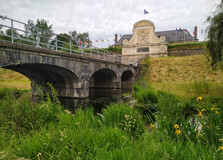
The Lille Citadel, also known as the Citadelle de Lille, is one of the most iconic landmarks in Lille, France. Constructed in the late 17th century, the fortress has stood the test of time and remains a symbol of the city's military history. It was designed by the renowned military architect Vauban and is considered one of his finest works. The citadel is a must-visit destination for those interested in French military history, architecture, or simply looking for a beautiful place to explore while in Lille. How to Reach Lille Citadel, Lille The Lille Citadel is located in the heart of the city, making it easily accessible from many popular areas within Lille. If you're traveling by public transport, the best way to reach the citadel is by taking the metro to the Citadelle station, which is located on Line 1. From there, it’s just a short walk to the citadel itself. If you're coming from the city center, you can also take a bus or a tram. For those traveling by car, there are parking areas nearby, although it’s recommended to use public transport as parking can be limited around the citadel. Weather in Lille Lille has a temperate climate, characterized by cool winters and mild summers. The best time to visit the Lille Citadel is during the spring and summer months (from May to September), when the weather is warmer, and the surrounding park is in full bloom. Average temperatures during this time range from 15°C to 25°C (59°F to 77°F). The autumn months are also a good time to visit, with beautiful fall foliage adding charm to the citadel’s surroundings. During winter, temperatures can drop to around 0°C (32°F), and the city experiences occasional snowfall. However, even in winter, the citadel remains an impressive sight against the crisp weather. Just remember to dress warmly if you're visiting during this season. Opening Hours and Timings The Lille Citadel is open to the public, but its hours can vary depending on the season. The citadel itself is surrounded by a public park, which is open every day. However, the inner part of the citadel is a military installation, so access is restricted to the public. The public park around the citadel is open daily from 8:00 AM to 9:00 PM, and visitors can stroll through the park and enjoy its green spaces, fountains, and scenic views. The park is perfect for those who want to relax, have a picnic, or simply enjoy a peaceful walk. Access to the citadel’s interior, which is usually restricted, is sometimes permitted during special events or guided tours. It is always best to check in advance with the tourist information office or the official website for any updates regarding special events or tours. Why Lille Citadel is Famous for Lille? The Lille Citadel is famous for its exceptional design and historical significance. Constructed in 1667-1670 by the renowned French military engineer Vauban, the citadel was built to protect the city from potential invasions and to solidify French control over the region. The citadel is one of the most important examples of Vauban's military architecture, a design that is recognized as a UNESCO World Heritage site. Its star-shaped layout and strategic positioning on the edge of the city were crucial in defending Lille during times of war. Over the centuries, the citadel has witnessed numerous historical events, including the siege of Lille in 1708 during the War of Spanish Succession. Today, it remains a key symbol of Lille’s rich history, and its massive walls and defensive structures make it one of the most visited historical sites in the region. Entry and Visit Details about Lille Citadel Visiting the Lille Citadel is free if you're exploring the public park surrounding the fortress. The park is an excellent place for outdoor activities such as walking, jogging, or cycling, and it's perfect for a family picnic. The area is well-maintained and is a popular spot for locals as well as tourists. While the interior of the citadel is not open for public exploration on a regular basis, it is occasionally accessible during special events or organized tours. The best way to gain access to the citadel’s interior is through a guided tour, which may require a fee. These tours offer a deeper understanding of the citadel’s history, architecture, and role in the defense of the city. History and Architecture of Lille Citadel The history of the Lille Citadel dates back to 1667, when King Louis XIV commissioned the construction of the fortress after Lille was annexed by France from the Spanish Netherlands. The citadel was designed by Vauban, who was tasked with reinforcing the city’s defenses. Vauban’s design of the citadel was innovative and strategic, making it one of the most advanced fortresses of its time. The citadel’s most notable feature is its star-shaped layout, designed to maximize defense. The fortress is surrounded by deep moats and large walls, which were intended to protect the city from enemy attacks. Its structure is fortified with bastions, ravelins, and a series of defensive gates that make it an impressive feat of military engineering. Over the centuries, the citadel has been updated and renovated, but its core design remains intact. Today, the citadel is a perfect example of Vauban’s genius and is recognized for its contribution to military architecture. Things to Do at Lille Citadel While the interior of the Lille Citadel is not open to the public on a daily basis, there are still plenty of things to do around the citadel: Stroll through the Citadel Park: The park surrounding the citadel is an expansive green space where visitors can walk, jog, or simply relax. The park offers beautiful views of the citadel and is a great place for a picnic. Take a Guided Tour: Learn about the history and architecture of the citadel with a guided tour. These tours provide insight into Vauban’s design and the fortress’s role in defending Lille throughout history. Enjoy Outdoor Activities: The citadel park is perfect for outdoor activities, including cycling, jogging, or enjoying a leisurely walk. There are several bike paths that connect to the park. Explore Nearby Attractions: The Lille Citadel is located near other major attractions, such as the Parc de la Citadelle, the Lille Zoo, and the city center, making it a great starting point for a day of exploration. Facts about Lille Citadel The Lille Citadel was designed by the famous military architect Vauban, who designed over 30 fortresses in France. The citadel is considered one of the finest examples of Vauban’s military architecture and is listed as a UNESCO World Heritage site. The fortress is surrounded by a large moat and is strategically placed to protect the city from attacks. Today, the citadel is still used by the French military, which limits access to certain areas. The public park surrounding the citadel is a popular spot for both locals and tourists and offers great views of the fortress. Tips for Visiting Lille Citadel Wear Comfortable Shoes: The citadel is surrounded by a large park, and exploring the area requires some walking, so comfortable footwear is essential. Check for Special Events: If you're interested in visiting the interior of the citadel, be sure to check for any special events or tours that offer access to restricted areas. Bring a Picnic: The surrounding park is perfect for a picnic, so don’t forget to pack some snacks and enjoy a meal with a view of the citadel. Visit Early in the Day: For a peaceful visit, try to arrive early in the morning when the park is quieter and less crowded.
Explore More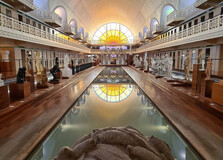
La Piscine Museum of Art and Industry
The La Piscine Museum of Art and Industry in Lille is a unique and fascinating destination for art and history lovers alike. Located in the heart of the city, this museum is housed in a former swimming pool, giving it an extraordinary charm. The museum not only showcases an impressive collection of fine arts, but also highlights the history of industrial art and design. The transformation of the building from a public bathhouse into an art museum makes it a striking example of adaptive reuse of architectural space, combining old-world charm with contemporary art. How to Reach La Piscine Museum of Art and Industry, Lille The La Piscine Museum of Art and Industry is located at 23 Rue de l'Isly in Lille, making it centrally located and easily accessible from various parts of the city. To get to the museum, the best public transport options are as follows: Metro: The museum is accessible via the Château d'Eau Metro Station on Line 1, which is only a short walk away from the museum entrance. Bus: Several buses connect to the museum, with stops near the museum, including buses 10, 27, and 34. Tram: Tram Line 2 also connects to stops near the museum, making it another convenient option for visitors. By Car: If you are driving, the museum is located within the city center, and there are nearby parking facilities, although it’s best to use public transport due to the city’s dense traffic. For those arriving from the Lille Flandres train station, it is only a short 15-minute walk to the museum, or you can opt for a short tram or bus ride. Weather in Lille Lille has a temperate maritime climate, which means that it experiences mild temperatures year-round, with cool winters and mild summers. The best time to visit La Piscine Museum of Art and Industry is during the spring and summer months when the weather is pleasant and conducive to walking around the city. During these months, temperatures range from 15°C to 25°C (59°F to 77°F), making it comfortable to explore the museum and nearby attractions. In winter, temperatures can drop to around 0°C (32°F), with occasional rainfall and cloudy skies. Even in winter, Lille remains an attractive destination, and the indoor environment of the museum ensures that it is an ideal place to visit regardless of the weather outside. Opening Hours and Timings The museum is open every day except for Mondays and public holidays, which makes it easy to plan a visit. The usual opening hours are from 10:00 AM to 6:00 PM, allowing plenty of time to explore its vast collection. It’s recommended to arrive early in the day to avoid crowds, especially during the weekend or during school holidays. Admission to temporary exhibitions may require separate tickets, while the main collections are included with the general entry ticket. Be sure to check the museum’s website for any changes to hours or special opening events, as these can occasionally occur due to exhibitions or public holidays. Why La Piscine Museum of Art and Industry is Famous for Lille? The La Piscine Museum of Art and Industry is famous not only for its impressive collection of art and industrial heritage but also for the stunning building in which it resides. Originally built in the 1930s as a public swimming pool, the building was repurposed in the 2000s to create one of the most unique museums in Europe. The juxtaposition of art and industrial design within the former pool creates an atmosphere that enhances the visitor’s experience. The museum's collection spans a variety of art forms, including fine arts, decorative arts, textiles, and ceramics, making it a true celebration of creative expression in all its forms. The museum has become a cultural hub in Lille, attracting both art aficionados and those with an interest in the history of industry and design. It is famous for its innovative approach to showcasing art in a space with historical significance, which enhances the experience of the artworks on display. Entry and Visit Details about La Piscine Museum of Art and Industry Entry to the museum is available at a reasonable price, with discounts for students, children, and seniors. Admission typically includes access to the permanent collection as well as any temporary exhibitions being held at the time. Special guided tours are available for those looking to learn more about the history of the building and its impressive art collection. The museum has a cafe where visitors can relax, grab a coffee, or enjoy a light meal while soaking in the atmosphere of this remarkable place. There is also a museum shop that sells a range of art-related products, including prints, books, and souvenirs. History and Architecture of La Piscine Museum of Art and Industry The La Piscine Museum of Art and Industry is located in a striking building originally designed as a public swimming pool. Completed in 1932, the Piscine of Lille was one of the largest public baths in the region. It became a symbol of the city’s modernity and urban development during the early 20th century. The building was designed in an Art Deco style, which was characteristic of the time, and featured intricate details such as mosaic tiles, grand arches, and an iconic swimming pool with a glass roof that allowed natural light to flood the space. In 2001, the building was repurposed as a museum, preserving much of the original architectural beauty while making the space suitable for housing art exhibitions. The swimming pool itself was transformed into a spectacular central hall, and the design successfully integrated the museum’s art collections while retaining the building’s historical charm. The combination of contemporary art with the building’s art-deco features creates a unique and visually stunning environment for visitors. Things to Do at La Piscine Museum of Art and Industry There are plenty of things to do at La Piscine Museum of Art and Industry: Explore the Permanent Collection: The museum houses an impressive collection of over 4,000 works, including paintings, sculptures, ceramics, and textiles from the 19th and 20th centuries. Enjoy Temporary Exhibitions: La Piscine frequently hosts temporary exhibitions showcasing contemporary artists or themes related to the industrial history of Lille. Guided Tours: Take part in a guided tour to learn more about the museum’s fascinating history and collections. Knowledgeable guides provide insights into the art and architecture of the museum. Relax in the Museum Café: The museum has a lovely café where visitors can enjoy refreshments while overlooking the museum’s beautiful courtyard and architectural features. Facts about La Piscine Museum of Art and Industry The museum was opened in 2001 after the building was transformed from a public swimming pool into a museum. La Piscine is known for its stunning Art Deco architecture, which has been preserved throughout the museum’s renovation. The museum’s collection spans a wide range of artistic movements, including works by famous French artists and decorative pieces from the industrial era. The museum also hosts various educational programs, workshops, and special events for visitors of all ages. Tips for Visiting La Piscine Museum of Art and Industry Arrive Early: To avoid crowds, it is advisable to visit early in the day or on weekdays. Wear Comfortable Shoes: The museum is large, and you’ll be doing a lot of walking. Comfortable footwear will make your visit more enjoyable. Check for Special Events: Be sure to check the museum’s website for any special exhibitions or events that may be taking place during your visit. Spend Time in the Café: The museum café offers a relaxing atmosphere with a nice selection of snacks and drinks. It’s a great place to unwind after exploring the exhibits.
Explore More
The Natural History Museum of Lille is one of the most captivating places to visit in the city, offering a fascinating insight into the world of nature and the evolution of life on Earth. Located in the heart of Lille, this museum is an important cultural and educational institution that attracts visitors of all ages. Whether you're a student of science, an animal lover, or simply looking for an enriching experience, the Natural History Museum provides an exciting exploration of natural history, biodiversity, and ecological science. How to Reach Natural History Museum, Lille The Natural History Museum is situated at 19 Rue de Bruxelles, 59000 Lille, making it easily accessible by various means of public transportation. Here are some of the best ways to get there: Metro: The closest metro station to the museum is République Beaux-Arts on Line 1. From here, it is only a 10-minute walk to the museum. Bus: Several bus routes pass near the museum, including routes 10, 34, and 12, which stop at or near the République Beaux-Arts station. Tram: The Lille Flandres tram stop is approximately a 15-minute walk from the museum and is well connected to various tram lines. By Car: If you're driving, the museum is located within Lille’s city center. Parking is available nearby, though it is recommended to use public transport due to limited parking spaces in the area. If you're coming from the Lille Flandres Train Station, it’s a short 10-minute tram ride or a 20-minute walk to the museum. Weather in Lille Lille experiences a temperate maritime climate, with relatively mild temperatures throughout the year. Winters are cool, with temperatures typically ranging between 1°C and 5°C (34°F and 41°F), while summers are mild with temperatures averaging between 16°C and 22°C (61°F to 72°F). Rainfall is common throughout the year, so it’s a good idea to bring an umbrella or raincoat, especially in the fall and winter months. The best time to visit the Natural History Museum is in spring and summer when the weather is pleasant and you can explore the museum’s surroundings and nearby parks as well. However, the museum is a great indoor destination regardless of the season, offering a perfect refuge from rainy or colder weather. Opening Hours and Timings The Natural History Museum of Lille is open to visitors every day except for Mondays and certain public holidays. The usual hours of operation are from 10:00 AM to 6:00 PM, with last entries typically allowed an hour before closing. The museum often hosts special events, exhibitions, and educational programs, so it is a good idea to check their website in advance for any changes to timings or closures. Admission is available throughout the day, but it is recommended to visit in the morning or early afternoon to avoid the larger crowds, especially on weekends or during school holidays. Why the Natural History Museum is Famous for Lille? The Natural History Museum of Lille is renowned for its diverse collection, which spans a variety of fields such as paleontology, zoology, botany, and geology. The museum’s displays showcase a wealth of specimens, including fossils, taxidermied animals, minerals, and plants, many of which are of great scientific and historical significance. What makes this museum particularly famous is its combination of educational and entertaining exhibits. It offers a hands-on experience, where visitors can explore interactive displays and learn about the natural world in a fun, engaging way. The museum is also home to a series of temporary exhibitions that delve into contemporary environmental issues, conservation, and biodiversity, making it a place where science, education, and awareness about nature come together. Entry and Visit Details about Natural History Museum, Lille Entry to the Natural History Museum of Lille is generally affordable, with discounts available for children, students, and seniors. Admission fees vary depending on whether you wish to visit only the permanent collection or include any special exhibitions. The museum offers free admission on the first Sunday of every month, making it a popular day for locals and tourists alike. Once inside, visitors will find a spacious and well-organized museum with various rooms dedicated to different aspects of natural history. The museum is family-friendly, with exhibits designed to engage children and adults alike. Educational programs, workshops, and special events are frequently held at the museum, giving visitors additional opportunities to learn about the natural world in a more interactive manner. History and Architecture of the Natural History Museum The Natural History Museum of Lille was founded in 1822, making it one of the oldest museums in the region. It has undergone various renovations and expansions over the years to accommodate the growing collection and modernize the space for better public engagement. The museum is housed in a historical building, which itself adds to the charm and character of the site. Its architecture is a blend of classical and modern elements, with intricate design features and large windows that allow natural light to flood the exhibition spaces. As you walk through the museum, you’ll see beautiful historic rooms that have been preserved while the exhibits have been updated with interactive technology. The building's original architectural features are complemented by new spaces designed for educational activities and temporary exhibitions. Things to Do at the Natural History Museum, Lille There are numerous exciting activities and things to do when visiting the Natural History Museum of Lille: Explore Permanent Exhibitions: Discover various collections of animals, fossils, minerals, and plants in the permanent exhibitions. The museum also features themed areas where you can learn about the Earth’s evolution, biodiversity, and the history of life on our planet. Attend Temporary Exhibitions: The museum regularly hosts temporary exhibitions that focus on current environmental issues, scientific discoveries, and global conservation efforts. These exhibitions are often interactive and provide visitors with a deeper understanding of the natural world. Participate in Educational Workshops: The museum offers a range of educational activities, including workshops and lectures, which are perfect for children, students, and adults who are eager to learn more about the environment and natural sciences. Take a Guided Tour: Enhance your visit with a guided tour to gain expert insights into the museum's exhibits. Knowledgeable guides will provide fascinating information about the displays, bringing the exhibits to life. Visit the Museum’s Garden: After touring the exhibits, relax in the museum’s lovely garden, which features various plants and offers a peaceful space for reflection. Facts about the Natural History Museum, Lille The museum has over 100,000 specimens on display, making it one of the largest natural history collections in France. It houses significant collections of fossils, including dinosaur bones and ancient plants, offering a glimpse into the past. The museum is also home to an impressive collection of taxidermy animals from various ecosystems around the world, providing a detailed look at wildlife diversity. It offers educational programs for children, including interactive exhibits and school visits, making it a popular destination for family outings. The museum frequently hosts temporary exhibitions on topics such as biodiversity, the impact of climate change, and sustainable living. Tips for Visiting the Natural History Museum, Lille Visit During Weekdays: To avoid crowds, try to visit on a weekday, especially if you're visiting with children or seeking a quiet experience. Check for Special Events: The museum frequently hosts special events and educational programs. Be sure to check the website for information on any upcoming workshops, lectures, or exhibitions. Bring Your Camera: With so many interesting displays, you’ll want to take plenty of photos. However, always be mindful of museum policies regarding photography. Wear Comfortable Shoes: Expect to walk through large exhibits, so comfortable footwear is essential for an enjoyable visit.
Explore More
Parc Barbieux is one of the most beautiful and tranquil green spaces in Lille, France. Nestled in the heart of the city, this sprawling park offers visitors a unique combination of lush landscapes, serene lakes, walking paths, and historical monuments. With its rich history, stunning architecture, and diverse activities, Parc Barbieux is a must-visit location for nature lovers, families, and those seeking a peaceful escape from the hustle and bustle of city life. How to Reach Parc Barbieux, Lille Parc Barbieux is conveniently located in the northeast of Lille, near the district of Villeneuve-d'Ascq, and is easily accessible by various forms of transport. Here are the most convenient ways to reach the park: Metro: The closest metro station is Villeneuve d'Ascq – Hôtel de Ville on Line 1, just a short walk from the park. Alternatively, the Fort de Mons station on Line 1 also provides access to the park. Bus: Several bus routes pass near Parc Barbieux, including routes 33 and 23. The closest bus stop is Parc Barbieux, which is right next to the park’s entrance. By Car: If you're driving, the park is easily accessible by car, and there are parking spaces available nearby. Be mindful of the busy area, especially on weekends, when the park is most visited. Walking or Biking: If you’re staying nearby, Parc Barbieux is a great place to visit on foot or by bike. The park is connected to the surrounding areas by pedestrian paths and cycling routes, making it easy to reach without using public transport. Once you arrive, you can explore the park at your own pace or join a guided tour for a more in-depth experience. Weather in Lille Lille enjoys a temperate maritime climate, which means that the weather can be quite variable throughout the year. In the spring and summer months (from April to September), the weather is generally mild to warm, with temperatures ranging from 10°C (50°F) to 25°C (77°F). This is the best time to visit Parc Barbieux, as the lush greenery is in full bloom, and the lakes and pathways are particularly inviting. During the fall (October to November) and winter (December to February), temperatures drop, and it can get quite chilly, with average temperatures ranging from 0°C (32°F) to 10°C (50°F). Rain is also more common during these months, so it’s a good idea to bring an umbrella or raincoat when visiting during this time. No matter the season, Parc Barbieux offers something beautiful to see. However, spring and summer offer the best conditions for a leisurely walk or picnic in the park. Opening Hours and Timings Parc Barbieux is open to the public all year round and can be accessed at any time. However, certain facilities and services, such as boat rentals or cafes, may have specific hours of operation: Park Hours: The park is open from dawn until dusk every day, providing plenty of time to explore and enjoy the scenery. Café/Restaurant Hours: The café within the park generally operates from 10:00 AM to 6:00 PM during the warmer months, though hours may vary during winter. Be sure to check the schedule if you plan to grab a bite to eat. Boat Rental: During the summer months, boat rental services are available on the park’s lakes. These are typically available from 10:00 AM to 6:00 PM, weather permitting. Why Famous for Lille? Parc Barbieux is famous for several reasons, making it one of Lille’s most beloved public spaces. The park’s combination of natural beauty, historical significance, and recreational activities makes it a top destination for locals and tourists alike. First and foremost, Parc Barbieux is known for its remarkable landscaping, which includes a stunning collection of trees, flowers, and plant species. The park is designed in a traditional English garden style, with winding paths, tranquil lakes, and grassy lawns perfect for picnics or simply relaxing under the sun. Additionally, Parc Barbieux is home to a variety of wildlife, including ducks, swans, and other bird species. The park’s natural beauty and serene atmosphere make it an ideal spot for photography and nature walks. Historically, the park is famous for its role in the industrial revolution, as it was once part of a larger estate owned by a prominent Lille family. It was opened to the public in the late 19th century and has since become an integral part of the city’s heritage and cultural life. Entry and Visit Details about Parc Barbieux, Lille Visiting Parc Barbieux is completely free of charge. There is no entry fee to access the park, making it an affordable and enjoyable experience for everyone. The park is open all year, and the only costs involved are for services such as boat rentals or food and drinks from the on-site café. The park is family-friendly and welcomes people of all ages. It’s a great spot for a family picnic, a relaxing day out with friends, or a solo stroll in nature. The park is well-maintained and clean, with plenty of benches and shaded areas to rest while you take in the surroundings. Parc Barbieux is also suitable for visitors with mobility issues, as it is accessible by paved pathways. Wheelchairs are available on request, and there are no major obstacles in the park for those with limited mobility. History and Architecture of Parc Barbieux The history of Parc Barbieux dates back to the 19th century when it was part of the private estate of the wealthy industrialists. Originally designed as a private garden, the estate was later opened to the public and transformed into the park we know today. The park’s design follows the principles of the English landscape garden, a style popular in Europe at the time, characterized by winding paths, large open spaces, and carefully curated natural elements. Throughout the park, visitors will find a variety of architectural elements, including charming bridges, fountains, and even a small pavilion by the lake. The park’s historical architecture blends seamlessly with its natural surroundings, creating a harmonious space where visitors can relax and immerse themselves in the beauty of both nature and design. Things to Do in Parc Barbieux, Lille Parc Barbieux is a versatile destination with plenty of activities for visitors of all ages. Here are some of the top things to do in the park: Stroll through the Gardens: Take a leisurely walk through the park’s beautifully manicured gardens and lush green spaces. The paths are perfect for walking or cycling, and you’ll encounter various points of interest along the way. Boat Ride: During the summer months, visitors can rent rowboats and paddle across the park’s serene lakes. This is a peaceful and enjoyable activity for families and couples. Birdwatching: The park is home to many species of birds, including ducks, swans, and other waterfowl. Bring your binoculars and enjoy some birdwatching by the lake. Relax by the Lake: Parc Barbieux features several lovely lakes where visitors can sit, relax, and enjoy the tranquility. These areas are perfect for reading, meditating, or simply unwinding in nature. Picnic and Outdoor Dining: The park is ideal for a family picnic, with plenty of green spaces to lay out a blanket and enjoy a meal outdoors. There is also a café in the park where you can grab a snack or coffee. Facts about Parc Barbieux, Lille The park covers an area of 35 hectares, making it one of the largest parks in Lille. Parc Barbieux was designed by renowned landscape architect Edmond Lamy in the 19th century. The park features two large lakes, both of which are home to various species of birds and aquatic life. The park is home to a wide range of tree species, including oak, beech, and chestnut trees, as well as colorful flowerbeds in the spring and summer. The park hosts various cultural events and festivals throughout the year, including outdoor concerts and theater performances. Tips for Visiting Parc Barbieux, Lille Bring Comfortable Shoes: The park covers a large area, so be sure to wear comfortable shoes for walking or cycling. Check the Weather: The park is best enjoyed during pleasant weather, so check the forecast before heading out, especially if you plan to picnic or take a boat ride. Don’t Miss the Café: Stop by the park’s café for a coffee or light snack while enjoying the peaceful surroundings. Respect the Wildlife: While the park’s birds and animals are a highlight, please respect their space and refrain from feeding them. Stay Hydrated: Bring a water bottle, especially during the warmer months, to stay hydrated while exploring the park.
Explore More
Le Zoo de Lille is one of the most charming and accessible wildlife destinations in the heart of Lille, France. Established as a public zoo, it offers visitors a chance to experience a wide range of animals from across the globe, all within the city’s urban landscape. Unlike many zoos that are situated far from city centers, Le Zoo de Lille is conveniently located, making it a perfect destination for families, nature enthusiasts, and anyone looking for a fun and educational experience in the city. The zoo's commitment to animal conservation and education adds to its importance in Lille's cultural and natural heritage. How to Reach Le Zoo de Lille, Lille Le Zoo de Lille is located in the Parc de la Citadelle, a historic park in the center of Lille. It is well-connected to the rest of the city through multiple transport options: Metro: The zoo is easily accessible by metro, with the closest station being Citadelle on Line 1. From the station, it is a short walk to the zoo entrance. Bus: Several bus routes serve the area, including routes 13 and 14, with stops near the zoo. Check the local bus schedule for the most convenient route from your location. By Car: If you are driving, Le Zoo de Lille is easily reachable by car. Parking spaces are available around the park and zoo. However, it can get crowded during weekends and holidays, so be sure to plan accordingly. Walking or Cycling: If you're staying nearby, the zoo is within walking or cycling distance from the city center. Lille has excellent pedestrian and bike-friendly paths, making it a pleasant journey to the zoo. Whether you are using public transportation or your own vehicle, reaching the zoo is straightforward and convenient. Weather in Lille Lille experiences a temperate maritime climate, which means that the weather can be unpredictable throughout the year. Summers (June to September) are typically mild, with temperatures ranging between 15°C (59°F) to 25°C (77°F), making it the ideal time to visit the zoo. Visitors can comfortably stroll through the zoo and enjoy outdoor exhibits and animal enclosures. During the winter months (December to February), temperatures drop to around 0°C (32°F) to 10°C (50°F). While it doesn’t snow heavily in Lille, it’s still important to dress warmly if you're visiting during this period. Spring and autumn can be a bit rainy, so it's a good idea to bring a raincoat or umbrella if you're planning to visit during these seasons. No matter the season, the zoo is a wonderful place to visit, with each time of year offering unique experiences. Opening Hours and Timings Le Zoo de Lille operates all year round, but the opening hours vary depending on the time of year. Here are the general operating hours: Summer Season (April to September): The zoo is open from 9:30 AM to 6:00 PM, allowing visitors ample time to explore the entire zoo. Winter Season (October to March): During the colder months, the zoo typically opens from 9:30 AM to 5:00 PM. It’s important to check the zoo’s schedule ahead of time as hours may change due to special events or weather conditions. Keep in mind that the zoo may be closed on certain holidays, so it’s always a good idea to check their official website for the most current information about hours and special events. Why Famous for Lille? Le Zoo de Lille is famous for being one of the few zoos located in a city center, making it highly accessible for both locals and tourists. It is a unique blend of urban life and nature, with its location in the beautiful Parc de la Citadelle, a historic park dating back to the 17th century. The zoo is known for its rich diversity of animals, offering a chance to see a variety of species, from the smallest insects to larger animals like lions, elephants, and primates. The zoo is also renowned for its educational programs, conservation efforts, and animal welfare initiatives. It is home to over 400 animals representing more than 50 species, including both exotic and native animals. The zoo has a commitment to maintaining a safe and enriching environment for its residents, contributing to local and global conservation efforts. Le Zoo de Lille is also famous for its family-friendly atmosphere, with interactive exhibits and educational activities designed to engage children and adults alike. Whether you're a wildlife enthusiast or simply looking for a relaxing day out, the zoo is a perfect destination in Lille. Entry and Visit Details about Le Zoo de Lille, Lille One of the best aspects of Le Zoo de Lille is that entry is completely free! Visitors can enjoy the zoo's diverse exhibits without having to pay an entry fee. However, the zoo does encourage donations to support its conservation efforts and animal welfare programs. Donations help maintain the zoo and improve the experience for both animals and visitors. The zoo is family-friendly, with facilities such as picnic areas, a playground for children, and educational programs available for school groups. It’s a perfect destination for families looking to spend a few hours learning about animals and conservation. While the zoo is free, there are paid services and activities, such as guided tours, souvenir shops, and special events. You can also enjoy light refreshments at the zoo’s café, offering snacks and drinks to keep you refreshed as you explore the park. History and Architecture of Le Zoo de Lille Le Zoo de Lille was founded in 1950, initially as a small zoo to house a collection of animals in the city’s Parc de la Citadelle. Over the years, the zoo has expanded and evolved, becoming a modern facility dedicated to animal conservation and education. It has grown to house hundreds of animals, including endangered species and animals that are native to the region. The zoo’s architecture is a blend of natural and modern design elements. The enclosures and animal habitats have been carefully designed to mimic the animals' natural environments, offering them the space and safety they need to thrive. The park itself is located within the Citadel, which was designed by Vauban, a renowned French military engineer, adding a historic charm to the zoo’s surroundings. The zoo’s location within the Citadel park is also significant from an architectural perspective, as it integrates the beauty of historical landscaping with modern structures, creating a unique and attractive setting for the animals and visitors alike. Things to Do in Le Zoo de Lille Le Zoo de Lille offers a variety of activities for visitors of all ages. Some of the best things to do in the zoo include: Animal Watching: With over 400 animals from more than 50 species, there’s plenty to see. Watch exotic animals such as lions, tigers, elephants, and more. There are also smaller animals like monkeys, reptiles, and birds. Interactive Exhibits: The zoo regularly hosts interactive exhibits and animal encounters, where visitors can learn about different species and even get up close to some of the animals. Picnics and Relaxation: Take advantage of the scenic spots in the Parc de la Citadelle for a relaxing picnic. The park is perfect for enjoying a meal while surrounded by nature. Educational Programs: Le Zoo de Lille offers educational activities for children and families. These programs teach about wildlife conservation and the animals’ natural behaviors and habitats. Guided Tours: For a more in-depth experience, consider taking a guided tour where experts share fascinating information about the zoo's animals, history, and conservation efforts. Facts about Le Zoo de Lille Le Zoo de Lille houses over 400 animals from 50 different species. The zoo is part of the Parc de la Citadelle, a historical site in Lille, offering a unique blend of nature and culture. Entry to the zoo is free, but donations are encouraged to support animal welfare and conservation efforts. The zoo is home to several endangered species, making it an important center for wildlife preservation. It offers educational programs and activities to raise awareness about biodiversity and environmental conservation. Tips for Visiting Le Zoo de Lille Wear Comfortable Shoes: The zoo is located within a large park, so be prepared to walk and explore. Check the Weather: Visit during the warmer months for the best experience, especially if you want to enjoy outdoor exhibits and activities. Arrive Early: Arriving early will give you the best chance to see the animals at their most active times. Bring Snacks and Water: While there are places to buy snacks, it's always a good idea to bring some water and food, especially if you're planning to stay for several hours. Respect the Animals: Be mindful of the animals’ space and refrain from feeding them.
Explore More
The Place de la Bourse is one of the most iconic landmarks in Bordeaux, France. It is a masterpiece of 18th-century French classical architecture and is known for its stunning symmetry and the famous Miroir d'eau, the world's largest reflecting pool. How to Reach Place de la Bourse, Bordeaux The Place de la Bourse is located in the heart of Bordeaux and can be easily accessed: By Tram: Take Line C to the "Place de la Bourse" stop. By Bus: Several bus lines, including 24 and 45, stop nearby. By Foot: It is within walking distance from the city center and the Garonne River. Weather in Bordeaux Bordeaux has an oceanic climate with mild temperatures: Spring (March-May): Mild and pleasant with blooming flowers. Summer (June-August): Warm and sunny, perfect for sightseeing. Autumn (September-November): Cool and picturesque with golden foliage. Winter (December-February): Chilly but rarely freezing. Timing and Entry Details The Place de la Bourse is an open public square and can be visited at any time, free of charge. Why is Place de la Bourse Famous? The Place de la Bourse is renowned for: Its stunning 18th-century architecture designed by Ange-Jacques Gabriel. The Miroir d'eau, which beautifully reflects the square. Its significance in Bordeaux’s history as a symbol of economic prosperity. History and Architecture Built between 1730 and 1775, Place de la Bourse was designed by Ange-Jacques Gabriel to glorify the economic power of Bordeaux. The square features elegant classical buildings, with sculptures and intricate facades showcasing the artistic brilliance of the period. Things to Do at Place de la Bourse Admire the Architecture: Observe the grand buildings surrounding the square. Visit the Miroir d'eau: Experience the world’s largest reflecting pool. Enjoy Riverside Walks: Take a scenic stroll along the Garonne River. Photography: Capture the stunning reflections of the square. Interesting Facts about Place de la Bourse It was originally called Place Royale before the French Revolution. The Miroir d'eau covers an area of 3,450 square meters. The square was designed to symbolize the prosperity of Bordeaux’s trade. Tips for Visiting Visit at sunset for the most breathtaking views. Wear comfortable shoes as the area is best explored on foot. Check for events and light shows that sometimes take place at the Miroir d'eau.
Explore MoreClassical Spain With Paris 9 Nights - 10 Days Tour
10 Days/ 9 Night
Barcelona - Paris - Madrid - Seville - Granada
France And Swiss Alps 10 Nights - 11 Days Tour
11 Days/ 10 Night
Paris - Lyon - Zurich - Lucerne
European Discovery Classic 11 Nights - 12 Days Tour
12 Days/ 11 Night
Paris - Venice - Florence - Munich - Amsterdam - Innsbruck - Rome - Lucerne
From Madrid To Paris 6 Nights - 7 Days Tour
7 Days/ 6 Night
Barcelona - Paris - Madrid
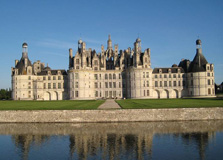
Palace Gate, Bordeaux The Palace Gate (Porte Cailhau) is a historic monument in Bordeaux, France. It served as the main entrance to the city from the 15th century and stands as a magnificent example of medieval architecture. How to Reach Palace Gate, Bordeaux The Palace Gate is centrally located and easily accessible: By Tram: Take Tram Line C to the "Place de la Bourse" stop, then walk a short distance. By Bus: Several bus routes pass through the area, making it convenient to reach. By Foot: Located in the old town, it is easily accessible for pedestrians exploring the city. Weather in Bordeaux Bordeaux enjoys a temperate oceanic climate: Spring (March-May): Mild and pleasant, perfect for sightseeing. Summer (June-August): Warm and sunny, ideal for walking tours. Autumn (September-November): Cool with stunning fall colors. Winter (December-February): Chilly but generally mild compared to northern Europe. Timing and Entry Details Palace Gate is open to visitors daily from 10 AM to 6 PM. Entry is usually free, but guided tours may have a small fee. Why is Palace Gate Famous? The Palace Gate is famous for: Its stunning medieval and Gothic architectural features. Being one of the oldest gates in Bordeaux, dating back to 1495. Its historical significance as a defensive structure of the city. History and Architecture The Palace Gate was built in honor of King Charles VIII. It stands at 35 meters tall and showcases a blend of medieval and Renaissance styles, featuring intricate stone carvings, turrets, and arched gateways. Things to Do at Palace Gate Explore the Gate: Walk around and admire its detailed stonework. Visit the Museum: Learn about Bordeaux's medieval history inside the gate. Take Photos: Capture stunning views of the gate and surrounding historic streets. Stroll Along the Garonne River: Enjoy scenic views near the gate. Interesting Facts about Palace Gate It was originally a defensive gate protecting the city from invaders. The gate is dedicated to King Charles VIII after his victory in Italy. It was once connected to the old city walls of Bordeaux. Tips for Visiting Visit early in the morning for fewer crowds. Take a guided tour to learn more about its history. Wear comfortable shoes for walking around the historic center.
Explore More
The Big Bell (Grosse Cloche) is one of the most iconic monuments in Bordeaux, France. It is a well-preserved medieval bell tower that once served as a city gate and was used to signal important events. How to Reach Big Bell, Bordeaux The Big Bell is centrally located in Bordeaux and can be reached by various means: By Tram: Take Tram Line A or B to the "Sainte-Catherine" stop, then walk a short distance. By Bus: Several bus routes pass through the city center, making it easy to access. By Foot: Located in the old town, it is easily accessible while exploring Bordeaux. Weather in Bordeaux Bordeaux experiences a mild oceanic climate: Spring (March-May): Pleasant temperatures, ideal for sightseeing. Summer (June-August): Warm and sunny, great for walking tours. Autumn (September-November): Cooler temperatures with scenic fall colors. Winter (December-February): Mild but can be rainy. Timing and Entry Details The Big Bell is open to visitors from 10 AM to 6 PM, though timings may vary. Entry is generally free, but guided tours might require a small fee. Why is Big Bell Famous? The Big Bell is famous for: Its historic role as part of Bordeaux’s fortifications. Being one of the few remaining medieval structures in the city. Its impressive bell, weighing over 7,500 kg, which used to ring for important events. History and Architecture The Big Bell was built in the 13th century and was once part of the city’s defensive walls. The current structure dates back to the 15th century and features twin circular towers with a large bell in between. The clock, added in the 18th century, remains a highlight. Things to Do at Big Bell Explore the Bell Tower: Admire its medieval design and historical significance. Learn the History: Read about its past as a city gate and prison. Photography: Capture the stunning façade and nearby old town streets. Walk Around Old Bordeaux: Enjoy the charming narrow streets and historic buildings. Interesting Facts about Big Bell It once served as a prison for young offenders. The bell was used to warn citizens of fires and invasions. The clock was designed by renowned 18th-century clockmaker Paul Lepaute. Tips for Visiting Visit in the morning to avoid crowds. Take a guided tour to learn detailed history. Wear comfortable shoes for exploring the nearby old town.
Explore More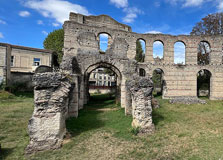
Palais Gallien is the only remaining Roman amphitheater in Bordeaux, France. This ancient structure offers a glimpse into the city's Roman past and is a must-visit for history enthusiasts. How to Reach Palais Gallien, Bordeaux Palais Gallien is located near the city center and can be accessed by: By Tram: Take Tram Line B and get off at "Gambetta" station, followed by a short walk. By Bus: Several buses stop nearby. By Foot: Easily reachable from Place des Quinconces and other central landmarks. Weather in Bordeaux Bordeaux enjoys an oceanic climate: Spring (March-May): Mild and comfortable for walking tours. Summer (June-August): Warm with some hot days. Autumn (September-November): Cool and sometimes rainy. Winter (December-February): Chilly but rarely freezing. Timing and Entry Details The ruins are accessible at all times for free, but guided tours may have specific schedules. Why is Palais Gallien Famous? Palais Gallien is renowned for: Being the last remnant of Roman Bordeaux. Once hosting gladiator battles and spectacles. Its unique elliptical shape and historic importance. History and Architecture Built in the 2nd century AD, this amphitheater once held over 15,000 spectators. Today, only fragments of the outer walls remain, showing intricate Roman brickwork. Things to Do at Palais Gallien Explore the Ruins: Admire the surviving structures. Join a Guided Tour: Learn about its rich history. Photography: Capture the contrast between ancient ruins and modern Bordeaux. Interesting Facts about Palais Gallien It was once Bordeaux’s grand entertainment center. Legends say it was named after Emperor Gallienus. Only a small portion of the original structure remains today. Tips for Visiting Visit during daylight hours for the best views. Pair your visit with a walk through nearby historic areas. Consider taking a guided tour for deeper insights.
Explore More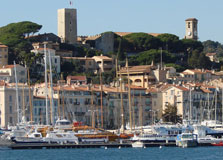
Le Suquet is the historic old town of Cannes, offering breathtaking views, charming cobbled streets, and a glimpse into the city's rich past. Located on a hill overlooking the famous Boulevard de la Croisette and the harbor, Le Suquet is a must-visit destination for those looking to explore Cannes beyond its glamorous film festival image. How to Reach Le Suquet, Cannes You can reach Le Suquet through various means: By Air: The nearest airport is Nice Côte d'Azur Airport, about 27 km from Cannes. By Train: Cannes train station is well-connected to major French cities. By Car: Le Suquet is accessible by car, but parking may be limited in the old town. By Public Transport: Local buses and taxis provide easy access to Le Suquet. Weather in Le Suquet, Cannes Cannes enjoys a Mediterranean climate: Spring (March-May): Warm and pleasant with temperatures around 15-22°C (59-72°F). Summer (June-August): Hot and sunny, reaching up to 30°C (86°F). Autumn (September-November): Mild with occasional rain. Winter (December-February): Cooler but rarely below 10°C (50°F). Timing and Entry Details Le Suquet is accessible year-round, and there is no entry fee to explore its charming streets. Some attractions, such as the Musée de la Castre, may have specific opening hours and ticket prices. Why is Le Suquet, Cannes Famous? Le Suquet is famous for its old-world charm, historic sites, panoramic views of Cannes, and traditional French ambiance. It offers a stark contrast to the modern, glamorous parts of Cannes, making it a cultural and historical treasure. History and Architecture Le Suquet was originally a medieval settlement and the heart of Cannes before its expansion. The area is characterized by narrow, winding streets, old stone buildings, and structures such as the Church of Our Lady of Hope and the Musée de la Castre, housed in a former medieval monastery. Things to Do in Le Suquet, Cannes Visit the Musée de la Castre: Explore this historic museum showcasing art and artifacts. Enjoy the View from the Hilltop: Experience stunning panoramic views of Cannes and the Mediterranean. Walk Along Rue Saint-Antoine: A picturesque street lined with restaurants and shops. Discover the Church of Our Lady of Hope: A beautiful 16th-century church with a peaceful atmosphere. Interesting Facts about Le Suquet, Cannes Le Suquet is the oldest part of Cannes and was originally a fishing village. The area offers the best views of the Cannes Film Festival venue, the Palais des Festivals. It remains one of the best places to experience authentic French culture in Cannes. Tips for Visiting Le Suquet, Cannes Wear comfortable shoes, as the streets are steep and cobbled. Visit early in the morning or in the evening to avoid crowds. Bring a camera to capture the breathtaking views from the top.
Explore More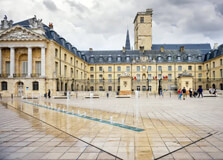
Palace of the Dukes of Burgundy
The **Palace of the Dukes of Burgundy** (Palais des Ducs de Bourgogne) is one of the most iconic historical landmarks in the city of Dijon, located in the heart of the **Burgundy** region of France. This magnificent palace, once the residence of the powerful Dukes of Burgundy, stands as a symbol of the region’s rich history and architectural brilliance. Today, the palace is a key tourist attraction, offering visitors a fascinating glimpse into the grandeur of the past. History of the Palace of the Dukes of Burgundy The **Palace of the Dukes of Burgundy** dates back to the **14th century**, during the time when the Dukes of Burgundy were one of the most influential families in Europe. The palace was initially a fortified castle and served as the residence of the dukes. It was expanded and remodeled over the centuries, reflecting the changing architectural styles and the growing wealth of the Burgundy region. During the reign of **Philip the Good** (15th century), the palace was at its peak. It became a political and cultural center, where important decisions were made, and it also housed the court of the Dukes of Burgundy. However, in the early 16th century, the palace lost much of its significance after the annexation of Burgundy to France, and the Dukes were no longer in power. The palace was subsequently repurposed for various uses, including as the seat of local government. Architecture of the Palace of the Dukes of Burgundy The architecture of the **Palace of the Dukes of Burgundy** is a stunning example of **Gothic** and **Renaissance** styles, reflecting the rich history and grandeur of the Duchy of Burgundy. The palace consists of several buildings, including the main palace, the **Hôtel de Ville** (City Hall), and various towers, all surrounding a central courtyard. One of the standout features of the palace is its **beautifully detailed façade**, which combines **Gothic arches**, **stone carvings**, and **Renaissance elements**. The **tour de l'horloge** (clock tower) is another striking feature, with its intricate design and historic clock that still chimes today. Visitors can also explore the **interior** of the palace, which includes grand rooms and chambers once used by the dukes and their court. The **Salle des États** (Hall of States) is a particularly impressive room with magnificent paintings, tapestries, and murals depicting the power and splendor of the Burgundy dynasty. Why is the Palace of the Dukes of Burgundy Famous? The **Palace of the Dukes of Burgundy** is famous for several reasons. First and foremost, it was the seat of the **Dukes of Burgundy**, one of the most influential and wealthy noble families in medieval Europe. The palace is a symbol of their political and cultural dominance, as well as their significant role in European history during the 14th and 15th centuries. Another reason for the palace's fame is its **architectural beauty**. The combination of **Gothic** and **Renaissance** styles makes it one of the most important examples of French palaces from the medieval period. The **Hôtel de Ville**, located within the palace complex, is a masterpiece of **Renaissance** architecture, and the entire building is a testament to the wealth and power of the Dukes of Burgundy. Additionally, the palace is famous for its historical significance. It was not only the residence of the dukes but also served as a **political and cultural hub** for the region. Today, it houses several museums, including the **Musée des Beaux-Arts** (Museum of Fine Arts), which showcases art and artifacts from the medieval and Renaissance periods, making it an important cultural site in Dijon. How to Reach the Palace of the Dukes of Burgundy Getting to the **Palace of the Dukes of Burgundy** is easy, as it is located in the heart of **Dijon**, near many other popular attractions. Here are the best ways to reach the palace: By Public Transport: Dijon has an efficient public transport system, including trams and buses. The closest tram stop is **Palais des Ducs**, just a short walk from the entrance of the palace. There are also several bus lines that stop nearby. By Foot: If you're staying in the city center, the palace is easily accessible by foot. It is located within walking distance of many other popular tourist attractions, such as **Place de la Libération** and **Notre-Dame Church**. By Car: If you're driving, you can park in nearby public parking lots. However, parking in the historic center of Dijon can be limited, so it's advisable to park in one of the larger parking structures and walk to the palace. Weather in Dijon Dijon has a **temperate climate**, with mild winters and warm summers. The best time to visit the **Palace of the Dukes of Burgundy** is during the **spring and summer** months, from **April to October**, when the weather is pleasant, and the city comes alive with outdoor events and festivals. The average temperature during these months ranges from **15°C to 25°C** (59°F to 77°F). During the **winter months**, the temperature can drop, with average temperatures ranging from **0°C to 5°C** (32°F to 41°F). While it may be chilly, the palace remains open year-round, and visiting during the off-season means fewer crowds. Timing and Entry Details The **Palace of the Dukes of Burgundy** is open to the public throughout the week, with certain areas and museums operating within specific hours. Here are the general opening hours: Opening Hours: 9:30 AM to 6:00 PM (Monday to Saturday) Sunday Hours: 10:00 AM to 5:00 PM Entry Fee: Entrance to the **Hôtel de Ville** and other parts of the palace is free, but to visit the **Musée des Beaux-Arts** (Museum of Fine Arts), there is an entry fee of around €5 to €7. Things to Do at the Palace of the Dukes of Burgundy Visitors to the **Palace of the Dukes of Burgundy** can enjoy a range of activities and experiences: Explore the Museum: The **Musée des Beaux-Arts** is located inside the palace and showcases a wide range of art and historical artifacts from the medieval to the Renaissance period. It’s a great way to understand the cultural significance of the palace. Admire the Architecture: Take time to appreciate the stunning blend of **Gothic** and **Renaissance** architectural styles. The **Hôtel de Ville** and the **clock tower** are particular highlights. Visit the Courtyard: The central courtyard of the palace is a peaceful place to relax and enjoy the surroundings. It’s a great spot for photos. Attend a Cultural Event: The palace often hosts cultural events, including concerts and art exhibitions. Check the schedule before your visit to see if there’s anything happening during your stay. Facts and Tips about the Palace of the Dukes of Burgundy Did you know? The **Duke's Palace** was once the residence of the **Dukes of Burgundy**, one of the most powerful families in medieval Europe. The palace's rooms are filled with fascinating stories of politics, art, and culture from that time. Tip: Don’t forget to visit the **clock tower**, where you can climb to the top for a panoramic view of the city and surrounding area. Tip: If you're interested in art, allocate extra time to explore the **Musée des Beaux-Arts** located within the palace. The museum houses an impressive collection of art from the **Middle Ages** to the **Renaissance**. Tip: Wear comfortable shoes as there’s a lot to explore inside the palace and its surrounding area.
Explore More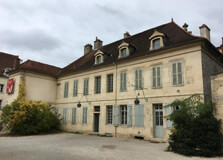
The **Museum of Burgundy Life** (Musée de la Vie Bourguignonne) is one of the most significant cultural landmarks in **Dijon**, located in the heart of the **Burgundy** region of France. This museum offers a fascinating glimpse into the daily life, traditions, and culture of the people of Burgundy through the centuries. Visitors can explore the museum's rich collection of artifacts that tell the story of **Burgundy's history**, customs, and lifestyle. History of the Museum of Burgundy Life The **Museum of Burgundy Life** was founded in the late **19th century**, with the aim of preserving and showcasing the region’s cultural heritage. The museum is housed in a beautiful **17th-century building**, which was originally the **former Hôtel de Besançon**, a grand mansion that was converted into a museum. The museum's collection grew over the years as donations of everyday objects, clothing, and tools from Burgundy's rural and urban life were made by local families. The museum’s collections span several centuries, focusing on the life and traditions of Burgundy from the **Middle Ages** to the early **20th century**. It covers everything from traditional Burgundy costumes to tools used in agriculture, wine-making, and local crafts. The museum's exhibits also highlight the region’s rich **gastronomy**, **arts**, and **craftsmanship**, making it a must-visit for anyone interested in the cultural diversity and history of **Burgundy**. Architecture of the Museum of Burgundy Life The museum is located in the **Hôtel de Besançon**, a **17th-century building** that is a fine example of French classical architecture. The building itself is an architectural masterpiece with **stone façades**, **elegant arches**, and beautifully preserved interiors. The museum's exhibition rooms retain much of the building's original charm, with high ceilings, large windows, and elegant wooden floors. The museum’s design highlights the historical significance of the building while providing the perfect space to showcase the extensive collection of Burgundy artifacts. The rooms are well-lit, spacious, and offer visitors a comfortable environment in which to explore the various exhibits. The blend of **historical architecture** with carefully curated displays makes for an enriching and immersive experience. Why is the Museum of Burgundy Life Famous? The **Museum of Burgundy Life** is famous for its detailed and comprehensive presentation of the **traditional life** of the people of Burgundy. Unlike other museums that focus solely on art or history, this museum emphasizes the **daily experiences** and **customs** of Burgundy’s inhabitants. It is an essential resource for those looking to understand the region's **heritage**, including its **rural traditions**, **crafts**, and **gastronomy**. The museum is also known for its impressive collection of **ethnographic objects**, such as **traditional costumes**, **farm tools**, and **household items**, all of which offer a fascinating look at the life of Burgundy's past generations. Many of these objects were donated by local families and are integral to understanding how Burgundy's culture has evolved over time. How to Reach the Museum of Burgundy Life Getting to the **Museum of Burgundy Life** is simple, as it is located in the heart of **Dijon**, near several other popular tourist attractions. Here are some of the best ways to reach the museum: By Public Transport: Dijon has an excellent public transportation system, including **trams** and **buses**. The museum is easily accessible by tram, with the **Darcy** tram stop just a short walk from the entrance. There are also several bus lines that stop nearby, making it easy to reach the museum from anywhere in the city. By Foot: If you're staying in the city center, the museum is easily accessible by foot. It is located near **Place Darcy**, a central square in Dijon, so you can walk to the museum from most central hotels and accommodations. By Car: If you're driving, you can park in nearby public parking areas. However, the streets around the museum can be narrow, and parking can be limited, so it’s best to park in one of the larger parking structures near the city center. Weather in Dijon Dijon has a **temperate climate**, with distinct seasons. The best time to visit the **Museum of Burgundy Life** is during the **spring and summer months**, from **April to October**, when the weather is mild and pleasant, with average temperatures ranging from **15°C to 25°C** (59°F to 77°F). This is an excellent time to explore the city and enjoy its outdoor cafes and attractions. In **winter**, the temperature drops, with average highs of around **5°C to 10°C** (41°F to 50°F). Although the weather can be chilly, the museum remains open year-round, and visiting during the off-season means fewer crowds and a more peaceful experience. Timing and Entry Details The **Museum of Burgundy Life** is open throughout the week, with certain areas and exhibitions available during specific hours. Here are the typical opening hours: Opening Hours: 10:00 AM to 6:00 PM (Tuesday to Sunday) Closed on Mondays. Entry Fee: The entrance fee to the museum is typically around €5 for adults, with discounted tickets available for students, children, and seniors. Entrance is free for children under 12. Things to Do at the Museum of Burgundy Life Visitors to the **Museum of Burgundy Life** can enjoy a wide range of activities and experiences: Explore the Exhibits: The museum has a vast collection of artifacts that highlight the **history** and **daily life** of the people of Burgundy. These include everything from **traditional costumes** to **agricultural tools**, as well as items used in local **crafts** and **gastronomy**. Learn About Local Traditions: The museum provides a deep dive into the **local customs** and **festivals** of Burgundy, showing visitors how the people of this region lived, worked, and celebrated over the centuries. Discover Burgundy’s Gastronomy: One of the museum’s highlights is its focus on **Burgundy’s culinary traditions**, including its famous wine-making practices. Visitors can learn about the region’s **vineyards**, **cheese-making**, and **culinary culture**. Take a Guided Tour: If you want to enhance your visit, consider taking a **guided tour** of the museum. Knowledgeable guides will provide additional context and insight into the exhibits, helping you gain a deeper understanding of Burgundy’s cultural heritage. Facts and Tips about the Museum of Burgundy Life Did you know? The museum's collection spans several centuries, with some exhibits dating back to the **Middle Ages**. It offers a rich look at Burgundy’s diverse heritage and traditions. Tip: Be sure to visit the section on **Burgundy's wine culture**, as the region is world-famous for its vineyards and wines. The museum provides a detailed look at the traditional methods of wine-making in Burgundy. Tip: If you're visiting during the summer months, consider checking out any temporary exhibitions or **cultural events** that might be happening at the museum. Tip: Plan your visit on a weekday if you prefer to avoid larger crowds, as weekends can see more visitors, especially during peak tourist seasons.
Explore More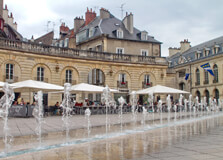
The **Place de la Libération** is one of the most iconic and historic squares in **Dijon**, located in the heart of the city. Known for its beautiful architecture and rich history, this square has become a must-visit landmark for tourists and locals alike. The square is not just a beautiful open space but also a central point in Dijon, offering access to several of the city's most notable attractions, shops, and cafes. Whether you're admiring its classical design or simply enjoying a stroll, Place de la Libération captures the essence of **Dijon's** charm and elegance. History of Place de la Libération The history of **Place de la Libération** dates back to the 18th century. Originally designed as a **royal square**, it was conceived during the reign of **Louis XV**. The square was constructed as part of a grand urban project to modernize Dijon, which was then the capital of the **Duchy of Burgundy**. Its layout, which consists of a large open area surrounded by classical buildings, was meant to represent the city's wealth and importance during that period. Over the years, the square has been a focal point for several key events in Dijon’s history. The name "Place de la Libération" was given to the square after **World War II** to commemorate the liberation of Dijon from Nazi occupation in **1944**. Since then, it has become a symbol of freedom and resilience, and a space for both celebration and remembrance. Architecture of Place de la Libération The **architecture** of Place de la Libération is a beautiful example of **18th-century classical French design**. The square is framed by elegant **buildings with arched facades**, **colonnades**, and ornate details that give it a stately and grand appearance. The most prominent feature of the square is the **Palais des Ducs de Bourgogne**, which stands at one end of the square. This impressive palace is an example of **Renaissance and Gothic architecture**, showcasing intricate stone carvings and large windows. The **palace courtyard** is often open to the public, allowing visitors to enjoy the beauty of the building up close. The square itself is **paved with stones**, creating an open area that serves as a gathering place for both locals and tourists. The **central fountain**, located in the middle of the square, adds to the charm of the place, offering a peaceful spot to relax and enjoy the surroundings. The architecture of Place de la Libération blends the old and the new, making it a perfect reflection of the city’s blend of history and modernity. Why is Place de la Libération Famous for Dijon? Place de la Libération is famous for several reasons. Firstly, it is **a central hub** in Dijon, connecting visitors to various attractions in the city. It is also one of the most photographed spots in the city due to its beauty and historical significance. The square is a symbol of **Dijon’s historical and political importance** and is a testament to the city’s transformation over the centuries. Another reason why this square is famous is its role in **public events** and **celebrations**. Throughout the year, Place de la Libération hosts numerous **festivals**, **markets**, and cultural events, including live performances and outdoor concerts. The square also serves as a meeting point for **tour groups** and **locals**, making it a lively space full of activity and energy. How to Reach Place de la Libération, Dijon Reaching Place de la Libération is easy, as it is centrally located in **Dijon**. Whether you are traveling by public transport, walking, or driving, the square is accessible from almost anywhere in the city. By Public Transport: Dijon has an excellent public transportation network, including trams and buses. The nearest tram station is **Place de la République**, which is just a short walk from Place de la Libération. Several bus lines also stop near the square, making it easy to reach from different parts of the city. By Foot: If you are staying in central Dijon, the square is within walking distance from most of the city’s major attractions. It’s a pleasant walk through the historical streets of Dijon, where you can admire the local architecture along the way. By Car: If you’re driving, there are several public parking lots nearby. However, parking can be limited, especially during peak tourist season, so it’s advisable to use public transport if possible. Weather in Dijon Dijon enjoys a **temperate climate**, with mild winters and warm summers, making it a pleasant destination year-round. The best time to visit Place de la Libération is during the **spring** and **summer** months, when temperatures range from **18°C to 25°C** (64°F to 77°F). During this time, the square is bustling with activity, and outdoor cafes and terraces are perfect for enjoying the view of the square and its surroundings. In **winter**, temperatures in Dijon can drop to around **2°C to 8°C** (36°F to 46°F), with occasional rainfall. While it can be a bit chilly, visiting during this time allows you to experience a quieter atmosphere, with fewer tourists. No matter the season, Dijon’s rich history and beautiful architecture make Place de la Libération an ideal destination. Timing and Entry Details Place de la Libération is an open public space and can be visited at any time of the day. There are no entrance fees for visiting the square itself, but there are several attractions nearby, such as the **Palais des Ducs de Bourgogne** and the **Dijon Museum of Fine Arts**, which may have entry fees. The square is always open, but the surrounding businesses, cafes, and museums generally operate from around **10:00 AM to 6:00 PM**, with extended hours in the summer months. It’s a good idea to check opening times for specific attractions you wish to visit when planning your trip. Things to Do at Place de la Libération Place de la Libération offers a variety of activities for visitors. Here are some of the best things to do when you visit: Admire the Architecture: The square is home to some of the most beautiful architecture in Dijon, including the **Palais des Ducs de Bourgogne** and the **fountain** in the center. Take a moment to appreciate the stunning classical design and historical significance of the buildings. Enjoy a Coffee at a Café: Several **cafes** and **restaurants** line the square, offering the perfect spot to relax and enjoy a coffee while people-watching. The **terraces** offer great views of the square and the surrounding area. Visit Nearby Attractions: The square is close to several major attractions, such as the **Dijon Museum of Fine Arts**, the **Church of Notre-Dame**, and the **Dijon Market**, so it’s easy to combine your visit to Place de la Libération with other nearby sites. Participate in Events: Depending on the time of year, you might be able to participate in or watch a **local event** or **festival** held in the square. These include live performances, outdoor markets, and celebrations. Facts and Tips about Place de la Libération Did You Know? The square is often used for **public celebrations** and **official ceremonies**, making it an important cultural and political site in Dijon. Tip: If you're visiting in the summer, try to get there early in the morning or later in the evening to avoid the crowds and experience the square in a quieter setting. Tip: Don't miss the **fountain** at the center of the square, especially in the summer, as it provides a refreshing backdrop for photographs. Tip: The square is surrounded by shops and cafes, so it’s the perfect place to relax after a busy day of sightseeing in Dijon.
Explore More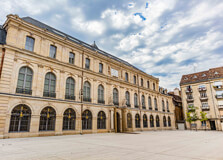
Archaeological Museum of Dijon
The **Archaeological Museum of Dijon** (Musée Archéologique de Dijon) is a must-visit destination for history lovers and anyone curious about the ancient past of this beautiful French city. Located in the heart of Dijon, the museum showcases the rich archaeological heritage of the region, with collections that span from prehistoric times to the medieval period. The museum's fascinating exhibits, housed in a historic building, offer a unique opportunity to explore the evolution of the region and its people over the centuries. History of the Archaeological Museum of Dijon The Archaeological Museum of Dijon was established in the 19th century, but its origins date back to the late 18th century when an interest in **local history and antiquities** started to grow in Dijon. The museum was originally part of the **Abbey of Saint-Bénigne**, an important religious site in the city, and its vast collection of archaeological artifacts was gathered from excavations in the region and other archaeological sites across **Burgundy**. The museum is housed in a beautiful **Renaissance-style** building that was once part of the **Saint-Bénigne Abbey**. Over the years, it has become one of the key cultural institutions in Dijon, offering a comprehensive look at the history of Burgundy through its impressive array of **ancient artifacts, sculptures, ceramics**, and **architectural pieces**. The museum provides invaluable insight into the ancient civilizations that once inhabited the area, from the **Gauls** to the **Romans**, and the **Medieval period**. Architecture of the Archaeological Museum of Dijon The **architecture** of the museum itself is a work of art. The museum is housed in the former **Saint-Bénigne Abbey**, which dates back to the 6th century, making the building itself a piece of history. The abbey was later transformed into a museum, retaining much of its original charm, with a stunning blend of **Gothic and Renaissance architecture**. Visitors can admire the **stone facades**, **vaulted ceilings**, and intricate **stone carvings** that decorate the museum's walls. The design of the building, with its **large windows**, **open courtyards**, and **wooden beams**, provides a perfect backdrop for the archaeological collections. Inside, the museum has been carefully curated to display the artifacts in a way that complements the architecture, allowing visitors to immerse themselves in the rich history of Dijon while appreciating the beauty of the building itself. Why is the Archaeological Museum of Dijon Famous? The Archaeological Museum of Dijon is famous for its extensive collection of **ancient artifacts** and its role in preserving the history of **Burgundy**. It is one of the oldest museums in France and holds an incredibly valuable collection that includes **Roman pottery**, **Greek sculptures**, **medieval tombstones**, and **medieval religious artifacts**. These objects help visitors understand the region's history, from its **early settlements** to its transformation into an important center of Roman culture. Aside from its impressive collection, the museum is also recognized for its role in **archaeological research** and its educational contributions. It regularly hosts special exhibitions and provides a platform for showcasing the ongoing discoveries made in the region. For anyone interested in the rich history of **Burgundy** and the ancient civilizations that once inhabited it, the Archaeological Museum of Dijon is an essential stop. How to Reach the Archaeological Museum of Dijon The Archaeological Museum of Dijon is located in the city center, making it easily accessible for both locals and tourists. Whether you're traveling by public transport, walking, or driving, reaching the museum is convenient. By Public Transport: Dijon has an efficient public transportation system, including buses and trams. The museum is located within walking distance from the **Dijon City Hall** and **Place de la Liberation**. You can take tram line **T1** or **T2**, and get off at **Darcy** or **Jaures**, both of which are close to the museum. By Foot: If you are staying in central Dijon, the Archaeological Museum is only a short walk from many of the city's key attractions. Strolling through the city's charming streets will also allow you to enjoy the beautiful **Renaissance architecture** of the area. By Car: If you're driving, there are several public parking areas around the city center. However, Dijon is a **pedestrian-friendly city**, and it may be easier to park in one of the nearby lots and walk to the museum. Weather in Dijon Dijon experiences a temperate climate, with **mild winters** and **warm summers**. The best time to visit the Archaeological Museum of Dijon is during the **spring** and **summer** months, from **April to September**, when the weather is pleasant and temperatures range from **15°C to 25°C** (59°F to 77°F). During this time, the museum is typically more crowded, so it is advisable to plan your visit early in the day to avoid the crowds. If you are visiting in **winter**, temperatures can drop to **2°C to 8°C** (36°F to 46°F). While it may be a bit chilly, the winter months offer a quieter and more peaceful experience at the museum, allowing you to enjoy the exhibits without the usual crowds. Timing and Entry Details The Archaeological Museum of Dijon is typically open from **Tuesday to Sunday**, with opening hours from **10:00 AM to 6:00 PM**. It is closed on Mondays, and public holidays may affect its schedule, so it’s a good idea to check the official website or call ahead to confirm opening hours before your visit. Entry to the museum is generally **free** for **EU residents** under the age of 26, while a small fee is charged for adults and non-EU visitors. Special exhibitions may have an additional charge. The museum also offers **guided tours** and educational workshops, which can be reserved in advance. Things to Do at the Archaeological Museum of Dijon Visitors to the Archaeological Museum of Dijon will find plenty to see and do. Here are some of the top activities: Explore the Exhibits: The museum's collection spans thousands of years, from prehistoric tools to Roman sculptures, medieval religious artifacts, and **Gallo-Roman** relics. Take your time to explore the diverse collections and learn about the region’s ancient past. Visit Special Exhibitions: The museum regularly hosts special exhibitions that delve deeper into specific aspects of **Burgundy’s history** and archaeology. These exhibitions offer a unique perspective on the region's cultural evolution. Take a Guided Tour: For a more enriching experience, join one of the museum's **guided tours**, where expert guides will take you through the history of the museum’s artifacts and their significance. Relax in the Courtyard: The museum is located in the former **Saint-Bénigne Abbey**, which includes a peaceful courtyard. After exploring the exhibits, take a break and enjoy the serenity of the historic grounds. Facts and Tips about the Archaeological Museum of Dijon Did You Know? The museum houses some of the finest examples of **Roman mosaics** and **medieval tombs** from Burgundy, which are a must-see for history enthusiasts. Tip: Plan to spend at least 1-2 hours exploring the museum, especially if you want to fully appreciate the collections and their historical context. Tip: Check out the museum's gift shop, which sells books, replicas, and souvenirs related to the museum's exhibits. Tip: If you're visiting with children, look out for any **interactive displays** or educational programs that are designed to make learning about history fun.
Explore More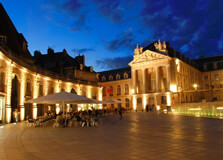
The **Museum of Fine Arts of Dijon** (Musée des Beaux-Arts de Dijon) is one of the most prominent cultural landmarks in the city of Dijon, located in the heart of the Burgundy region in France. The museum is a testament to the city’s rich artistic history and showcases an extensive collection of artwork, from **European paintings** to **decorative arts**. With its impressive galleries and carefully curated exhibits, it offers a glimpse into the artistic evolution of France and Europe over the centuries. History of the Museum of Fine Arts, Dijon The Museum of Fine Arts in Dijon was founded in the early 19th century, and its origins can be traced back to the **Duchy of Burgundy**. The museum’s collection initially began with a small group of artworks and artifacts that were brought together from various **monasteries**, **churches**, and **palaces** in the region. Over the years, the museum grew into one of the most significant institutions for fine art in France, housing works from various periods, including the **Middle Ages**, **Renaissance**, **Baroque**, and **Modern** eras. Today, the museum is located in the **Palace of the Dukes of Burgundy**, a historical building that was originally the seat of the powerful Dukes of Burgundy. The structure, which dates back to the 14th century, houses a rich collection of art, including **paintings**, **sculptures**, **ceramics**, and **decorative arts**. The museum is known not only for its historical significance but also for its impressive curation and educational role in the cultural landscape of Dijon and beyond. Architecture of the Museum of Fine Arts, Dijon The architecture of the Museum of Fine Arts is an attraction in itself. The museum is housed in the **Palace of the Dukes of Burgundy**, a remarkable building with **Gothic** and **Renaissance** elements. The palace was originally built to serve as the residence of the Dukes of Burgundy in the 14th century and has undergone several renovations over the centuries, which have added layers of historical significance to the building. The **grand facades**, **ornate courtyards**, and **intricate stone carvings** reflect the grandeur of the past. Inside the museum, visitors can explore beautiful **vaulted ceilings**, **wooden paneling**, and **stone galleries** that house some of the most cherished works of art in France. The building’s design is a blend of **classical and medieval** architectural styles, making it a perfect backdrop for the museum’s vast collection. Visitors can enjoy the **expansive galleries** that feature works spanning several centuries, as well as the **historical architecture** that adds to the immersive experience of the museum. Why is the Museum of Fine Arts Famous? The Museum of Fine Arts in Dijon is famous for its **extensive and diverse collection** of **European paintings**, sculptures, and decorative arts. Its collection includes works from renowned artists such as **Gustave Courbet**, **Jean-Baptiste Greuze**, and **Eugène Delacroix**, among others. The museum’s holdings also include **medieval art**, **Renaissance sculptures**, and **Baroque paintings**, making it a vital resource for understanding the artistic evolution of France and Europe. One of the most notable aspects of the museum is its impressive collection of **Italian Renaissance paintings** and **Dutch Baroque** works, which are some of the finest in France. It also boasts a **majestic collection of 18th-century French art**, including **rococo-style** paintings and decorative objects. Visitors can explore a wide range of artistic styles and movements, from the **early Renaissance** to **Impressionism**, giving them a well-rounded perspective on European art history. How to Reach the Museum of Fine Arts, Dijon The Museum of Fine Arts is conveniently located in the heart of Dijon, making it easily accessible for tourists and locals alike. Whether you're traveling by car, public transportation, or walking, you’ll find it simple to reach the museum. By Public Transport: Dijon has an efficient public transportation network, including buses and trams. The museum is located near the **Place de la Liberation**, and the closest tram stop is **Place Darcy**. From there, it’s only a short walk to the museum. By Foot: If you are staying in central Dijon, you can easily walk to the museum. It is located in a pedestrian-friendly area, and walking allows you to explore the charming streets of Dijon along the way. By Car: If you're driving, there are several parking lots around the city center. Parking near the museum is available, but it’s recommended to use public transportation or walk to avoid the hassle of finding parking in the busy downtown area. Weather in Dijon Dijon has a **temperate climate**, with four distinct seasons. The **best time to visit** the Museum of Fine Arts is during the **spring (April to June)** and **summer (July to September)** when the weather is mild and pleasant. Average temperatures range from **15°C to 25°C (59°F to 77°F)**, making it ideal for walking and sightseeing. If you prefer quieter periods to visit the museum, consider coming during **autumn (October to November)** or **winter (December to February)**. The weather during these seasons is cooler, with temperatures ranging from **2°C to 10°C (36°F to 50°F)**. While the museum is quieter in winter, it’s a great time for indoor activities, and the museum’s galleries are less crowded. Timing and Entry Details The Museum of Fine Arts in Dijon is generally open from **Tuesday to Sunday**, with opening hours from **10:00 AM to 6:00 PM**. It is closed on Mondays, and the schedule may vary during public holidays, so it is always a good idea to check the official website or call ahead before planning your visit. Entry to the museum is typically **free** for EU residents under the age of 26, while adults and non-EU visitors are charged a small entry fee. Special exhibitions may require an additional ticket. The museum also offers **guided tours** for visitors who wish to learn more about the artwork and the museum’s history. Things to Do at the Museum of Fine Arts, Dijon The Museum of Fine Arts offers a variety of activities for visitors. Here are some highlights: Explore the Permanent Collection: The museum’s collection spans several centuries of European art. Spend time admiring the masterpieces of **Impressionism**, **Renaissance**, **Baroque**, and **Modern art**. Attend Special Exhibitions: The museum regularly hosts rotating exhibitions that explore specific themes, artists, or movements. These exhibitions offer a deeper look into various artistic periods and are a great way to enhance your visit. Take a Guided Tour: For a more in-depth experience, consider booking a guided tour. The museum's knowledgeable guides will take you through the galleries and explain the history and significance of the pieces on display. Relax in the Museum Café: After exploring the exhibits, you can relax in the museum's café, where you can enjoy a coffee or a light snack while reflecting on the artworks you’ve seen. Facts and Tips about the Museum of Fine Arts, Dijon Did You Know? The museum is housed in the historic **Palace of the Dukes of Burgundy**, which is also home to **Dijon’s City Hall**. The stunning architecture is a historical landmark in itself. Tip: Spend some time admiring the **Italian Renaissance** and **Dutch Baroque** works. These are among the finest in France and offer a unique perspective on European art history. Tip: Check the museum’s website for **upcoming exhibitions** and special events. You may want to plan your visit around these to get the most out of your experience. Tip: Don’t forget to stop by the museum’s gift shop, which offers a selection of art-related books, souvenirs, and high-quality reproductions of famous artworks.
Explore More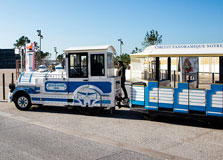
Les Petits Trains de Marseille
Les Petits Trains de Marseille offers a charming and convenient way to explore the city’s historic landmarks, scenic coastal views, and cultural sites. These small tourist trains take visitors on guided tours to some of Marseille’s most iconic locations. How to Reach Les Petits Trains de Marseille The starting point for Les Petits Trains de Marseille is near the Old Port (Vieux-Port), making it easy to reach: By Bus: Several city buses stop near the Old Port, including lines 49, 60, and 82. By Metro: Take Metro Line 1 and get off at the "Vieux-Port" station. By Car: Parking is available near the port, but spaces can be limited. By Foot: Easily accessible from many central locations in Marseille. Weather in Marseille Marseille enjoys a Mediterranean climate with warm summers and mild winters: Spring (March-May): Pleasant temperatures and blooming landscapes. Summer (June-August): Hot and sunny, perfect for sightseeing. Autumn (September-November): Mild weather, fewer crowds. Winter (December-February): Cool but enjoyable, great for peaceful exploration. Timing and Entry Details The tourist trains operate daily, with varying schedules depending on the season. Operating Hours: Typically from 10:00 AM to 6:00 PM. Entry Fee: Ticket prices vary depending on the tour route and age category. Why is Les Petits Trains de Marseille Famous? These small tourist trains offer an enjoyable and informative way to explore Marseille’s key attractions, such as the Basilica of Notre-Dame de la Garde, the Old Port, and historic neighborhoods like Le Panier. History and Architecture Les Petits Trains de Marseille were introduced as a convenient means for tourists to explore the city without excessive walking. The routes highlight Marseille’s rich maritime history, cultural landmarks, and picturesque views. Things to Do at Les Petits Trains de Marseille Take a Scenic Tour: Enjoy breathtaking views of Marseille’s coastline and historic sites. Visit Notre-Dame de la Garde: A must-see landmark offering panoramic city views. Explore Le Panier District: Discover Marseille’s oldest and most charming neighborhood. Enjoy a Guided Audio Tour: Learn about the history and culture of Marseille. Interesting Facts about Les Petits Trains de Marseille The trains provide a multilingual audio guide for tourists. They are an eco-friendly way to explore the city. The train’s route includes some of Marseille’s most photogenic locations. Tips for Visiting Arrive early to secure a good seat with the best views. Check the schedule in advance, as times may change seasonally. Bring a camera to capture stunning cityscapes along the route. Wear comfortable clothing, especially during the summer months.
Explore More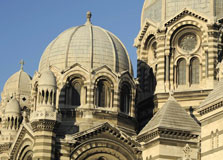
Cathédrale La Major, also known as Marseille Cathedral, is one of the most iconic landmarks in the city. It stands as a magnificent example of neo-Byzantine architecture and is an important religious and cultural monument in France. How to Reach Cathédrale La Major, Marseille You can reach the cathedral through various means of transport: By Bus: Several buses, including lines 49 and 60, stop near the cathedral. By Tram: Take Tram Line 2 and get off at "République Dames." By Metro: The nearest metro station is "Joliette" on Line 2. By Car: Parking is available nearby but may be limited during peak hours. By Foot: The cathedral is within walking distance from the Old Port of Marseille. Weather in Marseille Marseille enjoys a Mediterranean climate with warm summers and mild winters: Spring (March-May): Mild temperatures and blooming flowers. Summer (June-August): Hot and sunny, reaching up to 30°C (86°F). Autumn (September-November): Warm and pleasant with fewer tourists. Winter (December-February): Cool but rarely freezing, making it an ideal time for sightseeing. Timing and Entry Details The cathedral is open daily for visitors and worshippers. Opening Hours: 10:00 AM - 6:30 PM Entry Fee: Free entry for all visitors. Why is Cathédrale La Major Famous? The cathedral is famous for its grand neo-Byzantine design, stunning mosaics, and breathtaking sea views. It is one of the largest cathedrals in France and an important historical and religious landmark. History and Architecture Constructed between 1852 and 1896, Cathédrale La Major was built on the site of an older church. It was designed by architects Léon Vaudoyer and Henri-Jacques Espérandieu, incorporating Romanesque and Byzantine architectural elements. Exterior: The cathedral's exterior features alternating layers of white and green limestone, giving it a striking appearance. Interior: Inside, visitors can admire intricate mosaics, grand arches, and impressive sculptures. Domes: The cathedral has multiple domes, with the central dome reaching 70 meters in height. Things to Do at Cathédrale La Major Explore the Interior: Admire the stunning mosaics, artwork, and sculptures inside the cathedral. Enjoy the Panoramic View: The cathedral offers breathtaking views of the Mediterranean Sea and the Old Port. Visit Nearby Attractions: Explore the Old Port, MUCEM (Museum of European and Mediterranean Civilizations), and Le Panier district. Attend a Religious Service: Experience the spiritual atmosphere during mass or special ceremonies. Interesting Facts about Cathédrale La Major It is the only cathedral built in France during the 19th century. The cathedral can accommodate up to 3,000 worshippers. It is classified as a national monument of France. Tips for Visiting Visit in the morning or late afternoon to avoid crowds. Respect the religious nature of the site by dressing appropriately. Photography is allowed but without flash. Combine your visit with a tour of nearby attractions.
Explore More
Escale Borély is one of Marseille's most popular seaside destinations, known for its beautiful beaches, vibrant restaurants, and lively nightlife. It offers a perfect blend of relaxation and entertainment, making it a favorite spot for locals and tourists alike. How to Reach Escale Borély, Marseille You can reach Escale Borély through different transportation modes: By Bus: Take bus lines 19 or 83, which stop near the beach area. By Car: There is a large parking area available, but it can get crowded during peak hours. By Bike: Marseille has bike rental services, making cycling a scenic and eco-friendly option. By Foot: Escale Borély is easily accessible from nearby areas like Prado Beach. Weather in Marseille Marseille enjoys a Mediterranean climate, ideal for beach activities: Spring (March-May): Mild and pleasant with temperatures ranging from 15-22°C (59-72°F). Summer (June-August): Hot and sunny, with temperatures reaching up to 35°C (95°F). Autumn (September-November): Still warm, with occasional rainfall. Winter (December-February): Mild, with temperatures rarely dropping below 5°C (41°F). Timing and Entry Details Escale Borély is an open area with no fixed opening hours. Restaurants, bars, and shops operate at different times: Beaches: Open 24/7 but lifeguards are on duty during the day. Restaurants & Bars: Usually open from 10:00 AM - 2:00 AM. Shops & Boutiques: Typically open from 10:00 AM - 7:00 PM. Why is Escale Borély Famous? Escale Borély is famous for its stunning seaside promenade, luxurious dining options, and vibrant nightlife. It is a top spot for water sports, sunbathing, and social gatherings. The beautiful setting, with a mix of sandy beaches and green spaces, attracts visitors year-round. History and Architecture Originally developed as a leisure area, Escale Borély has transformed into a modern beachfront attraction. While it lacks historic architecture, it is known for its contemporary design, stylish cafes, and open-air seating areas that offer breathtaking sea views. Things to Do at Escale Borély Enjoy the Beaches: Relax on the sandy shores or take a dip in the Mediterranean Sea. Try Water Sports: Jet skiing, paddleboarding, and windsurfing are popular activities. Visit Restaurants & Bars: Enjoy fine dining or casual meals with a view of the sea. Walk Along the Promenade: A perfect place for an evening stroll with beautiful sunset views. Nightlife: Lively bars and clubs make it a great place to enjoy the nightlife in Marseille. Interesting Facts about Escale Borély Escale Borély hosts several events, including concerts and food festivals. The area is named after the Borély family, who played a significant role in Marseille's history. The nearby Parc Borély is one of the most beautiful green spaces in Marseille. Tips for Visiting Visit early in the morning or late in the afternoon to avoid crowds. Book restaurant reservations in advance during peak season. Carry sunscreen and a hat for protection against the strong sun. Check the weather forecast before planning a visit.
Explore MoreGlimpses Of Europe Land Only 8 Nights - 9 Days Tour
9 Days/ 8 Night
Paris - Amsterdam - Zurich - Frankfurt
European Magic 8 Nights - 9 Days Tour
9 Days/ 8 Night
Paris - Venice - Munich - Amsterdam - Lucerne
Paris Tour 4 Night 5 Days Package
5 Days/ 4 Night
Paris
Paris And Amsterdam Diaries Land Only 5 Nights - 6 Days Tour
6 Days/ 5 Night
Paris - Brussels - Amsterdam
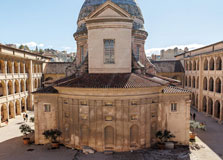
The Old Charity Center (La Vieille Charité) in Marseille is a historic architectural masterpiece and cultural hub. Originally built as a shelter for the poor in the 17th century, it now houses museums, art exhibitions, and cultural institutions. How to Reach Old Charity Center, Marseille You can reach the Old Charity Center through various transportation options: By Metro: Take Line 2 to "Jules Guesde" station, which is a short walk away. By Bus: Buses 49 and 55 stop near the site. By Car: Limited parking is available, so public transport is recommended. By Foot: Located in the Panier district, it is accessible by a scenic walk through Old Marseille. Weather in Marseille Marseille has a Mediterranean climate, making it ideal for visiting year-round: Spring (March-May): Mild temperatures ranging from 15-22°C (59-72°F). Summer (June-August): Hot and sunny, with highs up to 35°C (95°F). Autumn (September-November): Pleasant weather with occasional rain. Winter (December-February): Cool but rarely freezing, with temperatures around 5-12°C (41-54°F). Timing and Entry Details The Old Charity Center is open to visitors throughout the year with the following schedule: Tuesday to Sunday: 10:00 AM - 6:00 PM Closed on Mondays Entry Fee: Free entry to the courtyard; museum exhibitions have separate charges. Why is Old Charity Center Famous? The Old Charity Center is renowned for its stunning Baroque architecture and cultural significance. It serves as a major artistic and historical venue, featuring museums like the Museum of Mediterranean Archaeology and contemporary art exhibitions. History and Architecture Constructed between 1671 and 1749 by architect Pierre Puget, the Old Charity Center was originally designed as a hospice for the poor. The building is an excellent example of Baroque architecture, featuring an elegant courtyard and a central chapel with a striking dome. Things to Do at Old Charity Center Visit the Museums: Explore exhibitions of Mediterranean archaeology and contemporary art. Admire the Architecture: Walk through the historic courtyard and admire the intricate design. Attend Cultural Events: The center regularly hosts film screenings, workshops, and performances. Photography: The unique design makes it a fantastic spot for photography. Relax in Cafés: Enjoy a peaceful break at nearby cafés within the historic setting. Interesting Facts about Old Charity Center Originally built to house the poor, it has now become a leading cultural site. The central chapel is considered one of Marseille’s architectural masterpieces. It was used as barracks during the French Revolution. Tips for Visiting Visit early in the day to enjoy a peaceful atmosphere. Check museum schedules in advance for special exhibitions. Wear comfortable shoes as the Panier district has cobbled streets. Combine your visit with nearby attractions like the Marseille Cathedral.
Explore More
Abbey Saint Victor is one of the oldest religious sites in Marseille, dating back to the 5th century. This historic abbey is a remarkable example of medieval architecture and serves as a cultural and spiritual landmark in the city. How to Reach Abbey Saint Victor, Marseille You can reach Abbey Saint Victor using the following options: By Metro: Take Line 1 to "Vieux-Port" station, then walk for about 10 minutes. By Bus: Buses 55 and 60 have stops near the abbey. By Car: Parking is available nearby but can be limited. By Foot: A scenic walk from the Old Port takes you through historic streets to the abbey. Weather in Marseille Marseille has a Mediterranean climate, making it ideal for visiting throughout the year: Spring (March-May): Pleasant temperatures ranging from 15-22°C (59-72°F). Summer (June-August): Warm and sunny, with highs up to 35°C (95°F). Autumn (September-November): Mild weather with occasional rain. Winter (December-February): Cool but rarely freezing, around 5-12°C (41-54°F). Timing and Entry Details The abbey is open to visitors with the following schedule: Monday to Sunday: 9:00 AM - 6:00 PM Entry Fee: Free, but donations are appreciated. Why is Abbey Saint Victor Famous? The abbey is famous for its ancient crypts, Romanesque architecture, and historical significance. It has been a pilgrimage site for centuries and offers breathtaking views of the Old Port and the Mediterranean. History and Architecture Founded in the 5th century, the abbey has undergone several transformations. It was fortified in the Middle Ages and played a crucial role in the religious and cultural history of Marseille. The crypts house ancient sarcophagi and relics, adding to its historical depth. Things to Do at Abbey Saint Victor Explore the Crypts: Discover ancient relics and early Christian sarcophagi. Admire the Architecture: Observe the Romanesque style and fortified structure. Enjoy the Scenic Views: Capture panoramic views of the Old Port. Attend Religious Services: Experience the spiritual ambiance during mass. Visit Nearby Attractions: The abbey is close to the Old Port and Fort Saint-Nicolas. Interesting Facts about Abbey Saint Victor The abbey was named after Saint Victor, a Roman soldier martyred for his faith. Its crypts contain some of the oldest Christian tombs in France. The famous "Navette de Marseille" biscuits are blessed here every year on Candlemas. Tips for Visiting Visit early to avoid crowds and enjoy a peaceful experience. Wear comfortable shoes as the terrain around the abbey can be uneven. Don’t forget to bring a camera for stunning views of the city. Explore nearby restaurants to enjoy traditional Marseille cuisine after your visit.
Explore More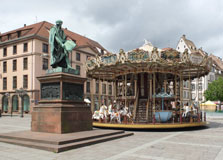
Place Gutenberg is one of the most famous squares in Strasbourg, located in the heart of the city near the Notre Dame Cathedral. Named after Johannes Gutenberg, the inventor of the printing press, the square is a historical and cultural landmark, offering visitors a glimpse into Strasbourg’s rich past. How to Reach Place Gutenberg, Strasbourg Place Gutenberg is well connected by various modes of transportation: By Tram: Take Tram Line A or D and get off at the "Homme de Fer" or "Langstross Grand’Rue" stop, which are within walking distance. By Bus: Several bus lines stop near the square. By Car: Parking is available at nearby public parking garages. By Foot: It is a short walk from major attractions in the city center. Weather in Strasbourg Strasbourg experiences a temperate oceanic climate with four distinct seasons: Spring (March-May): Mild temperatures, ideal for exploring the city. Summer (June-August): Warm and pleasant, with temperatures ranging from 20°C to 30°C (68°F-86°F). Autumn (September-November): Cool and comfortable, perfect for sightseeing. Winter (December-February): Cold, with occasional snowfall, adding charm to the city's Christmas markets. Timing and Entry Details Place Gutenberg is an open public square and can be visited at any time of the day or night. There are no entry fees. Why is Place Gutenberg Famous? The square is renowned for its historical significance, as it was named after Johannes Gutenberg, who revolutionized printing technology. It also serves as a meeting point and event space for cultural festivities and markets. History and Architecture Place Gutenberg has existed since the Middle Ages and was historically a marketplace and political hub. The notable statue of Johannes Gutenberg was erected in 1840 in recognition of his contributions. The square is surrounded by classic French and Alsatian architecture, with notable buildings like the Chamber of Commerce. Things to Do at Place Gutenberg Admire the Gutenberg Statue: A tribute to the inventor of the printing press. Explore Nearby Cafés: Enjoy a coffee while taking in the ambiance of the square. Visit the Strasbourg Cathedral: Just a short walk away, this iconic structure is a must-visit. Attend Seasonal Events: The square hosts various markets and cultural events throughout the year. Interesting Facts about Place Gutenberg The square was a major commercial and political hub in medieval Strasbourg. The Gutenberg statue was designed by sculptor David d’Angers. It serves as an exhibition space during the famous Strasbourg Christmas Market. Tips for Visiting Visit in the morning for a quieter experience. Try local Alsatian cuisine at nearby restaurants. If visiting in December, enjoy the festive decorations and Christmas market. Wear comfortable shoes, as the surrounding area is best explored on foot.
Explore More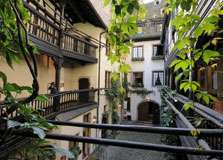
The Alsatian Museum in Strasbourg is a fascinating cultural institution dedicated to showcasing the traditions, customs, and daily life of the Alsace region. It houses an impressive collection of artifacts, furniture, costumes, and tools that offer a glimpse into Alsatian heritage. How to Reach Alsatian Museum, Strasbourg You can reach the museum through various modes of transportation: By Tram: Take tram lines A or D and get off at the "Porte de l'Hôpital" stop. By Bus: Several bus routes stop near the museum, making it easily accessible. By Car: Parking spaces are available nearby, but the city center can be busy. By Foot: Located in the historic center of Strasbourg, the museum is easily reachable on foot. Weather in Strasbourg Strasbourg experiences a temperate oceanic climate with four distinct seasons: Spring (March-May): Mild and pleasant with blooming flowers. Summer (June-August): Warm and ideal for exploring. Autumn (September-November): Cool with colorful foliage. Winter (December-February): Cold, sometimes snowy, perfect for visiting Christmas markets. Timing and Entry Details The museum operates with the following schedule: Opening Hours: 10:00 AM - 6:00 PM (Closed on Mondays) Entry Fee: A standard fee applies, with discounts for students and groups. Why is Alsatian Museum Famous? The museum is known for preserving and promoting the unique traditions of Alsace. Visitors can explore traditional Alsatian homes, handicrafts, and folk art, making it a cultural treasure in Strasbourg. History and Architecture Established in 1907, the museum is housed in a series of historic buildings that reflect traditional Alsatian architecture. The timber-framed structures create an authentic setting for the exhibitions. Things to Do at Alsatian Museum Explore Authentic Interiors: Experience recreated Alsatian homes from different eras. View Traditional Costumes: See regional attire worn in festivals and daily life. Learn About Alsatian Crafts: Discover pottery, weaving, and other handicrafts. Join Guided Tours: Gain insights into Alsace's rich history with expert guides. Interesting Facts about Alsatian Museum The museum showcases over 5,000 artifacts from rural Alsace. It is located in three connected 17th-century houses. It offers interactive exhibits and storytelling sessions for children. Tips for Visiting Visit during weekdays to avoid crowds. Take an audio guide for a detailed experience. Check for temporary exhibitions and special events. Wear comfortable shoes as there are multiple floors to explore.
Explore More
The Eiffel Tower is one of the most famous landmarks in the world, located in the heart of Paris, France. Standing at 330 meters, this iron lattice tower attracts millions of visitors every year. How to Reach Eiffel Tower The Eiffel Tower is well-connected and can be reached via: By Air: The nearest airports are Charles de Gaulle (CDG) and Orly (ORY). By Train: The nearest metro stations are Bir-Hakeim (Line 6) and Trocadéro (Line 9). By Bus: Several city buses, such as 42, 69, 72, and 82, stop near the tower. By Foot: It is a scenic walk from many parts of central Paris. Weather in Paris Paris has an oceanic climate: Spring (March-May): Mild temperatures with blooming flowers. Summer (June-August): Warm and sunny, ideal for visits. Autumn (September-November): Cool and picturesque. Winter (December-February): Chilly but magical, especially at night. Timing and Entry Details Opening Hours: Typically open from 9:30 AM to 11:45 PM. Entry Fee: Ticket prices vary depending on the level you wish to visit. Discounts are available for children and students. Why is the Eiffel Tower Famous? The Eiffel Tower is renowned for: Its iconic iron lattice structure. The breathtaking panoramic views of Paris from its observation decks. Being a symbol of France and an engineering marvel since its completion in 1889. History and Architecture Designed by Gustave Eiffel and completed in 1889 for the World's Fair, the Eiffel Tower was initially criticized but later became one of the most beloved monuments in the world. Things to Do at the Eiffel Tower Visit the observation decks for stunning city views. Dine at the restaurants on the tower, such as 58 Tour Eiffel. Watch the light show every evening. Take a scenic cruise on the Seine River nearby. Interesting Facts about the Eiffel Tower The Eiffel Tower was once the tallest structure in the world. It is repainted every 7 years with 60 tons of paint. The tower expands slightly in summer due to heat. Tips for Visiting Book tickets online to avoid long queues. Visit early in the morning or late at night for fewer crowds. Carry a light jacket as it can be windy at the top.
Explore More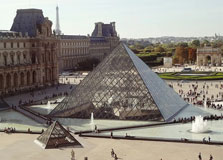
The Louvre Museum is one of the world's largest and most visited art museums, located in the heart of Paris, France. It is home to thousands of artworks, including the famous Mona Lisa and Venus de Milo. How to Reach The Louvre The Louvre is easily accessible by various means: By Air: The nearest airports are Charles de Gaulle (CDG) and Orly (ORY). By Metro: The closest station is Palais Royal – Musée du Louvre (Lines 1 and 7). By Bus: Buses 21, 24, 27, 39, 48, 68, 69, and 95 stop near the museum. By Foot: Located centrally, it's an easy walk from other Paris landmarks. Weather in Paris Paris has an oceanic climate: Spring (March-May): Pleasant temperatures and blooming gardens. Summer (June-August): Warm and lively, perfect for exploration. Autumn (September-November): Cooler weather with beautiful fall colors. Winter (December-February): Chilly but charming with Christmas lights. Timing and Entry Details Opening Hours: Typically open from 9:00 AM to 6:00 PM, closed on Tuesdays. Entry Fee: General admission is around €17, with free entry for visitors under 18 and on the first Saturday of each month after 6 PM. Why is The Louvre Famous? The Louvre is renowned for: Being the largest art museum in the world. Housing the Mona Lisa, Venus de Milo, and The Winged Victory of Samothrace. Its stunning glass pyramid entrance. History and Architecture The Louvre was originally a medieval fortress built in the 12th century and later transformed into a royal palace. In 1793, it was officially opened as a public museum. The modern glass pyramid entrance was added in 1989, designed by architect I. M. Pei. Things to Do at The Louvre Explore world-famous exhibits including Renaissance masterpieces and ancient artifacts. Take a guided tour for a deeper understanding of the artworks. Visit the museum at night for a unique experience. Relax in the nearby Tuileries Garden after your visit. Interesting Facts about The Louvre The Louvre has over 35,000 artworks on display. The Mona Lisa is protected by bulletproof glass. The museum receives over 9 million visitors annually. Tips for Visiting Buy tickets online to skip the long queues. Visit early in the morning or late in the evening to avoid crowds. Wear comfortable shoes as the museum is vast.
Explore More